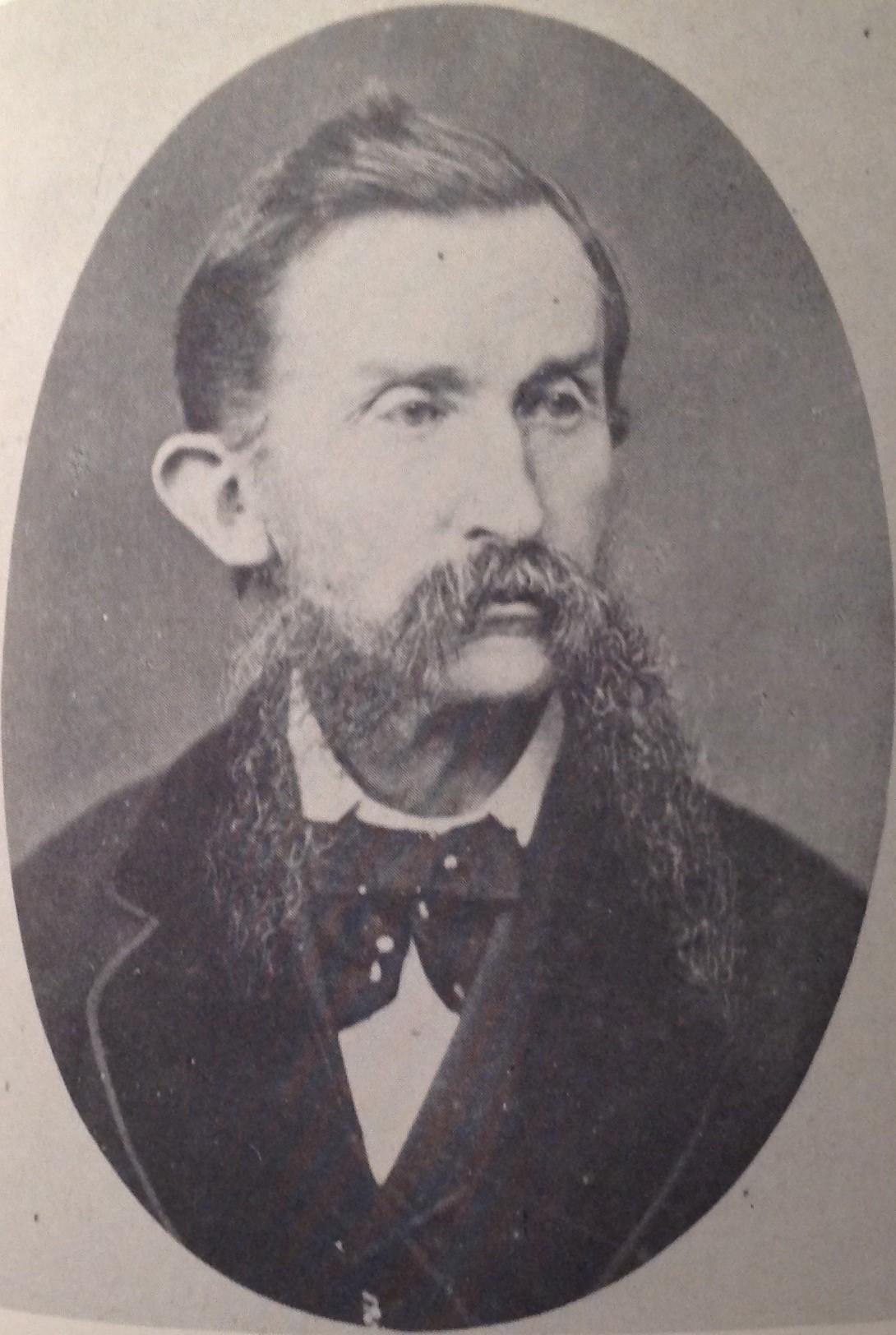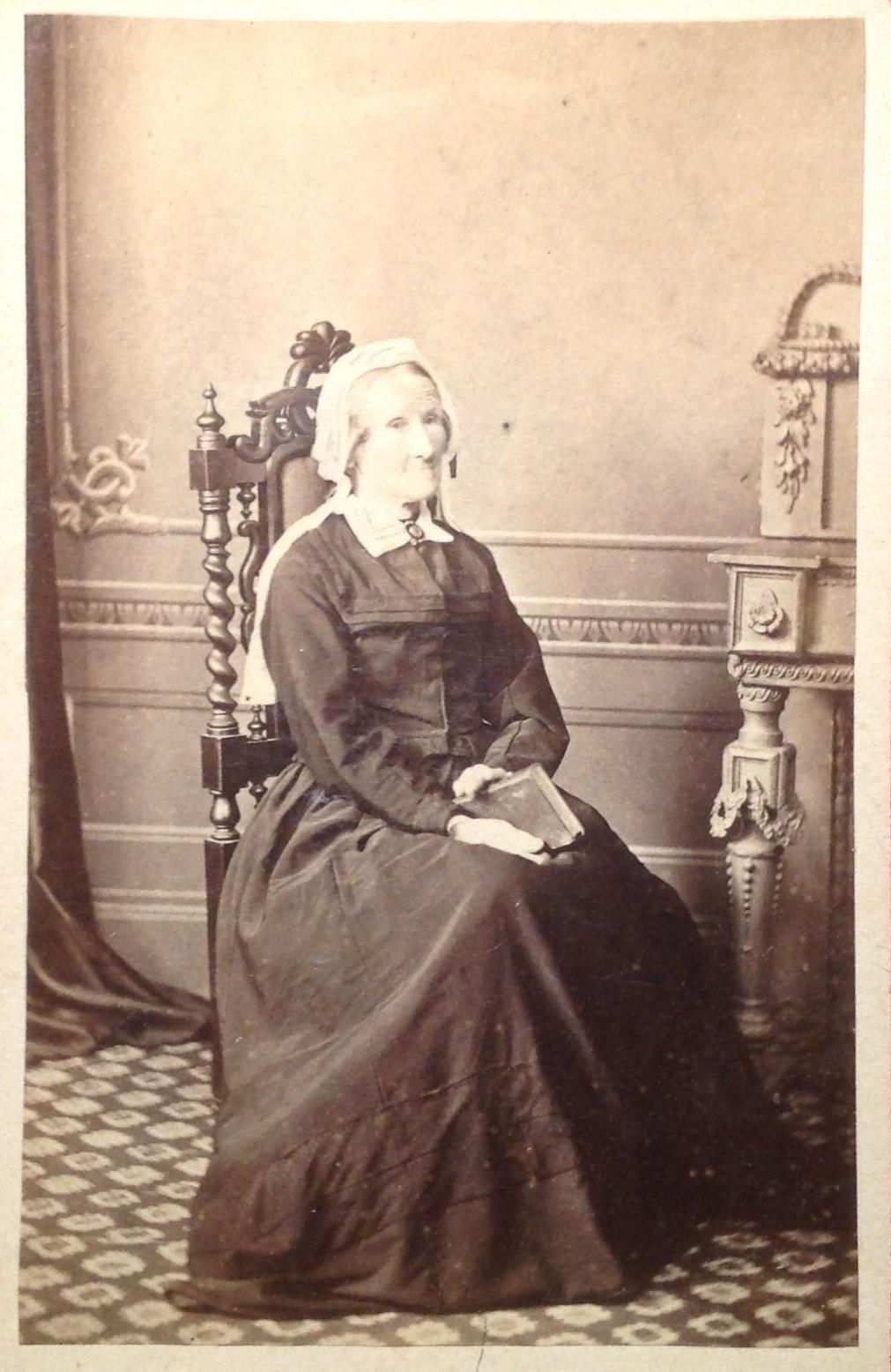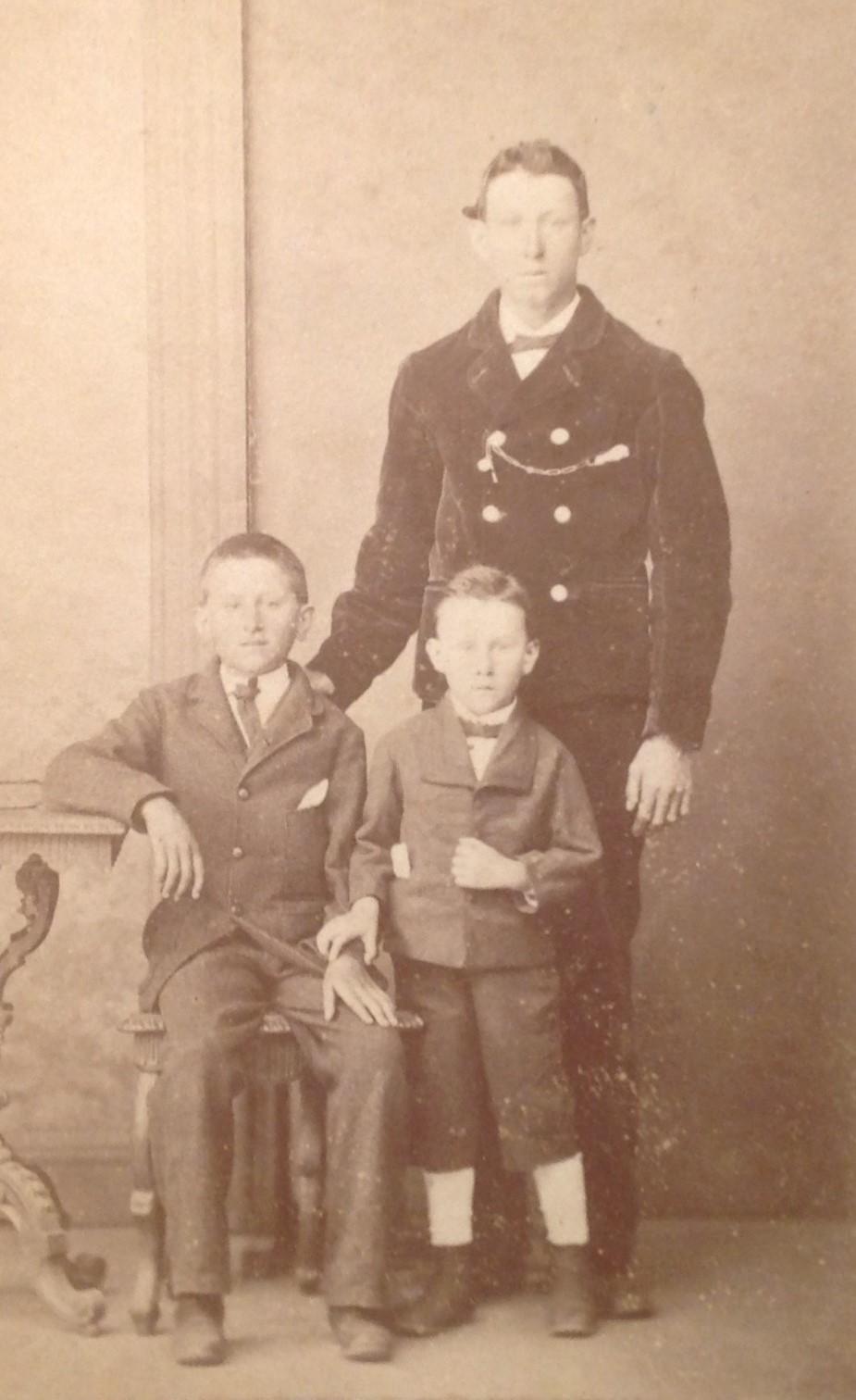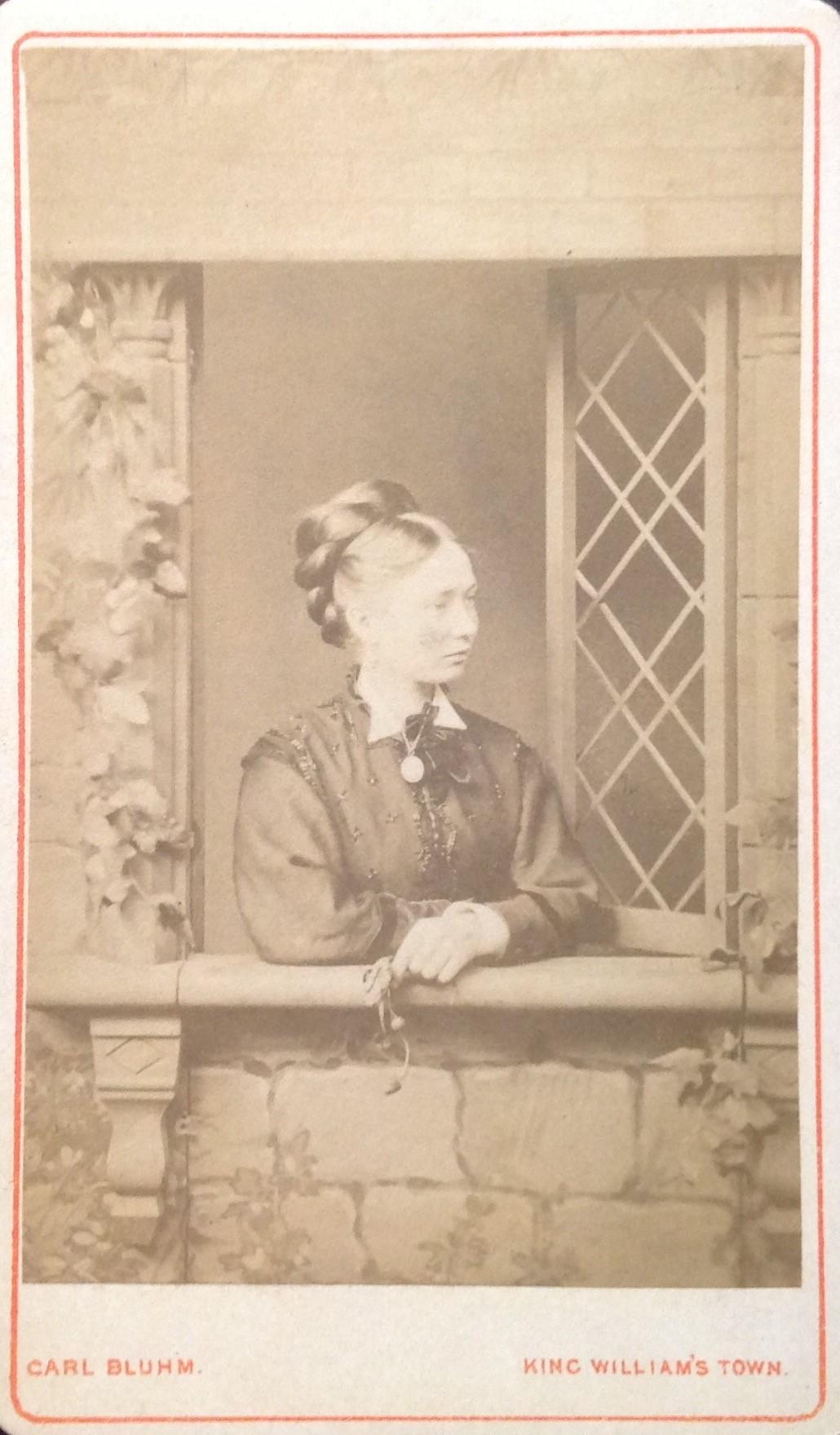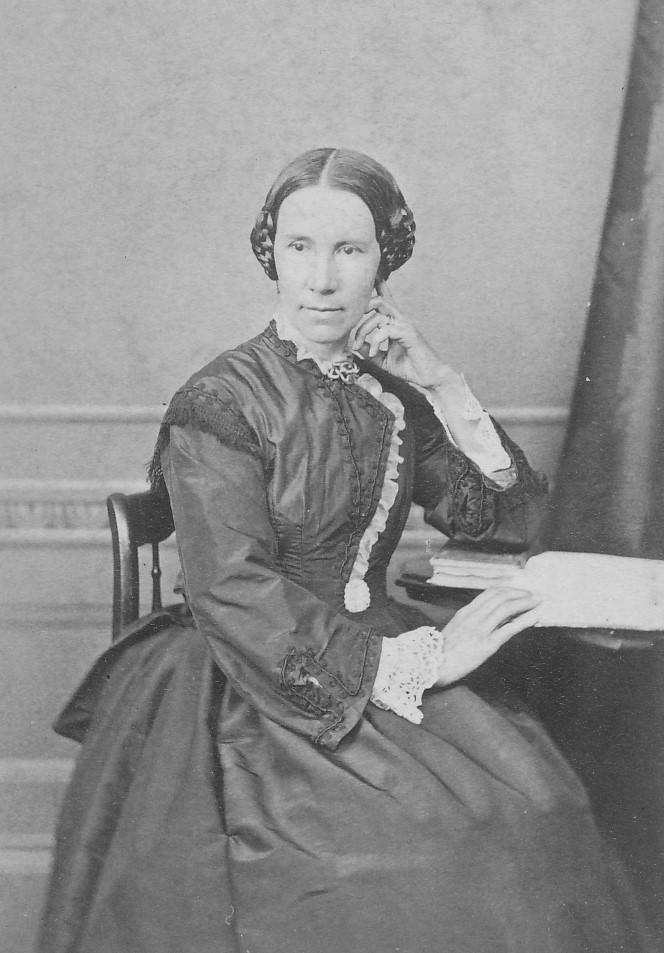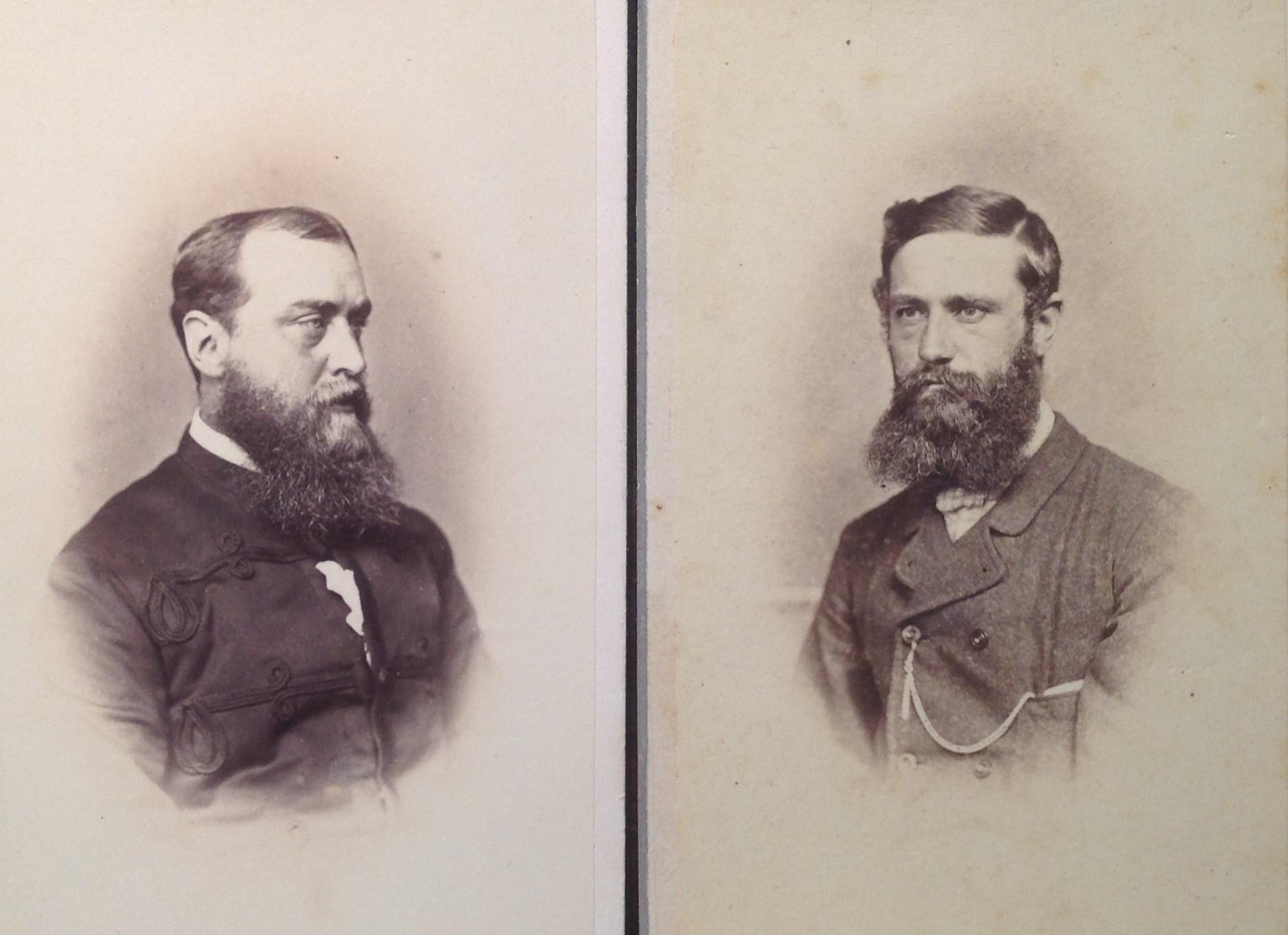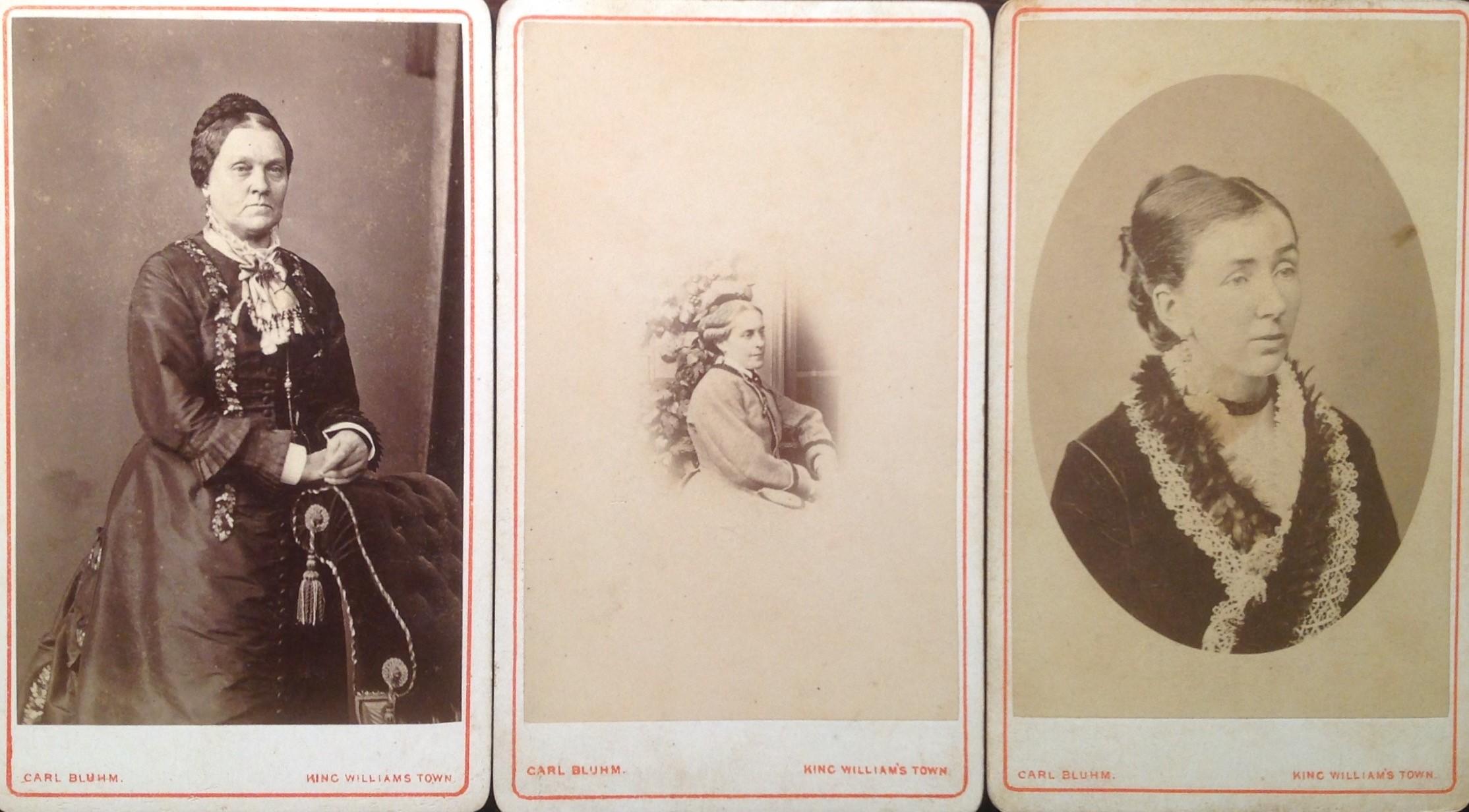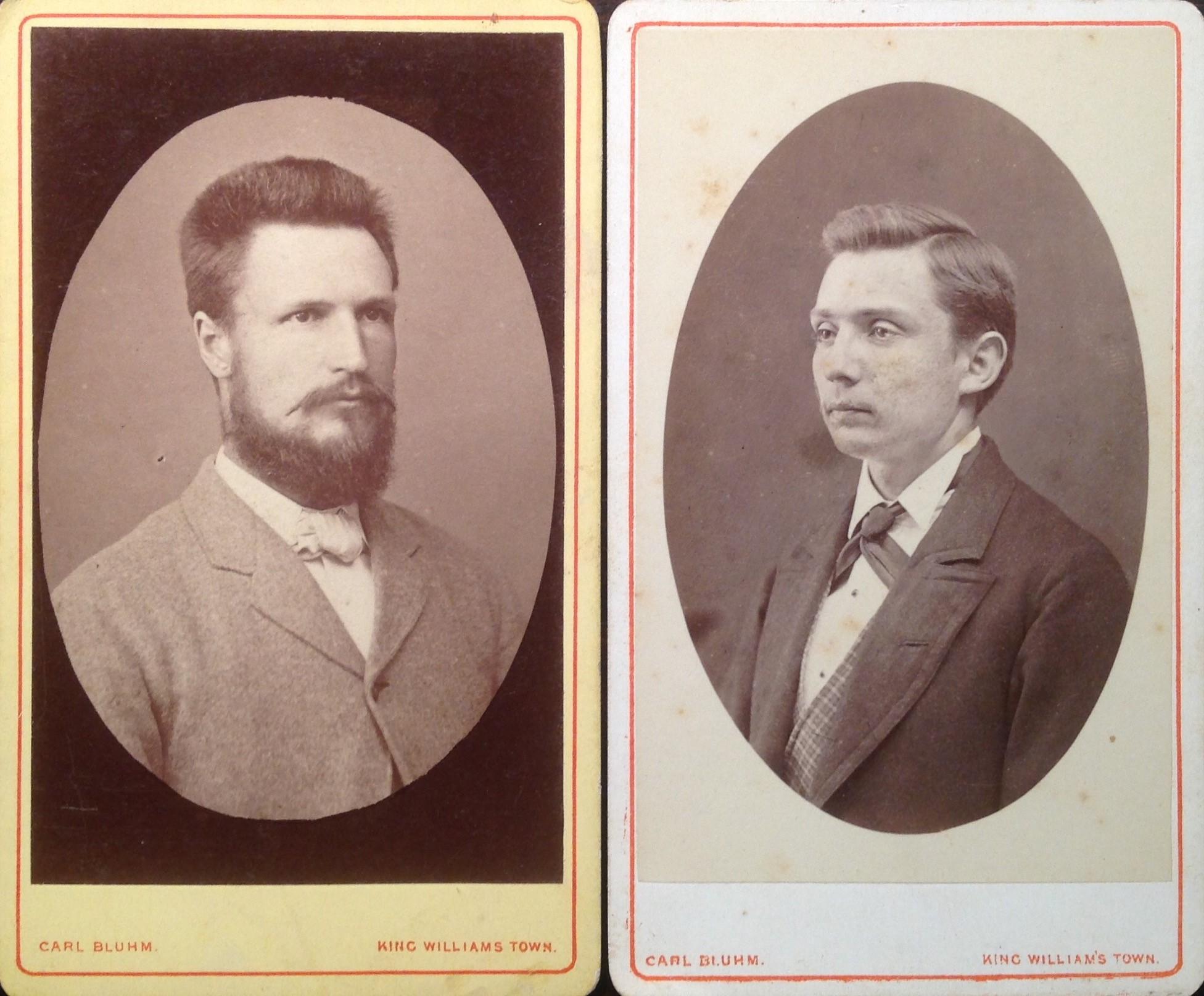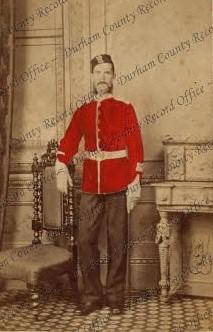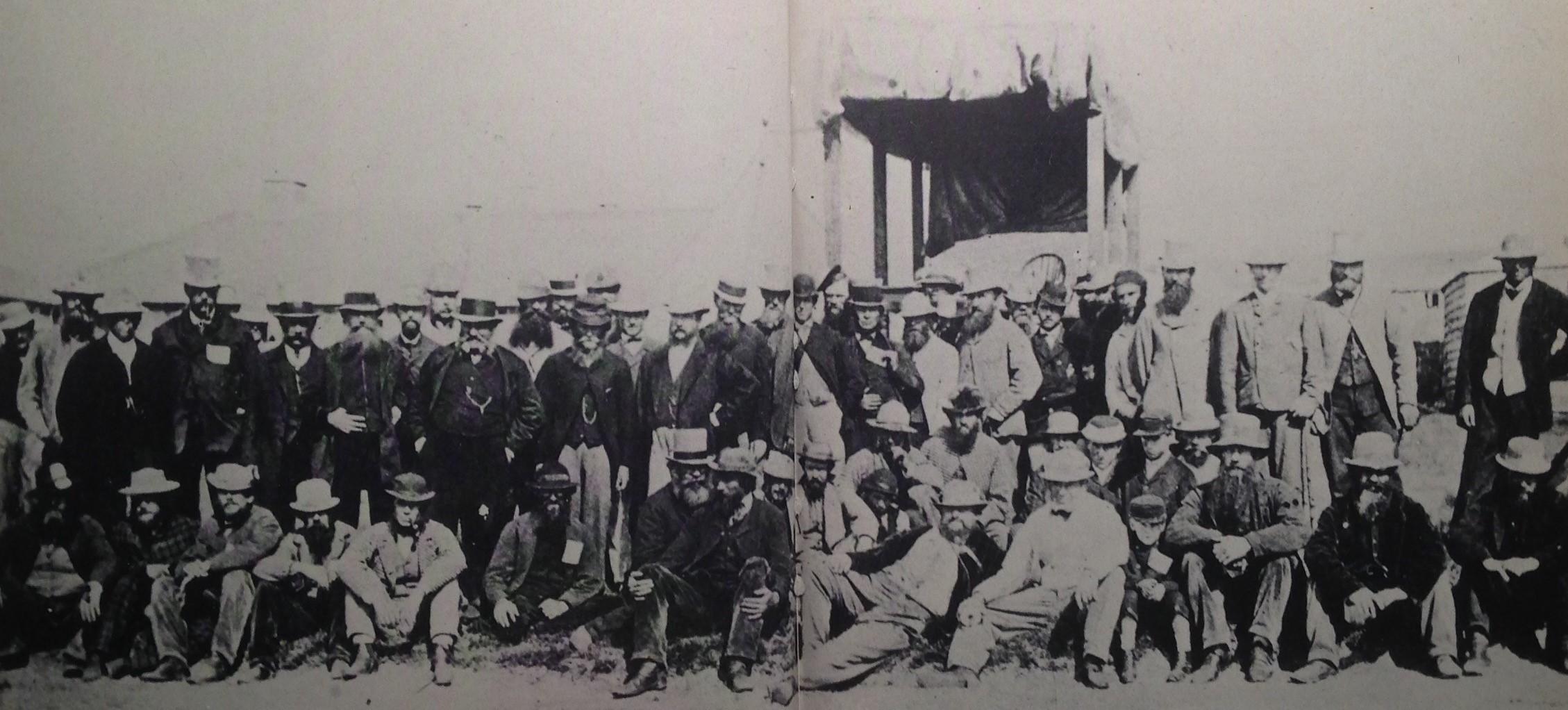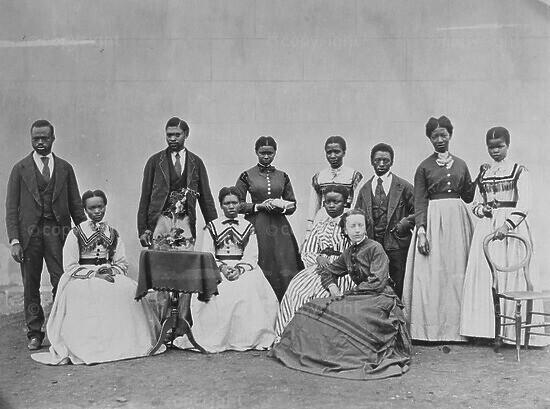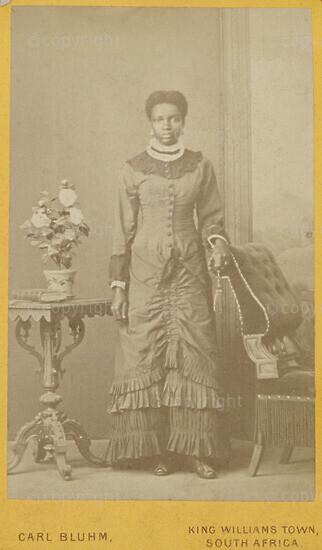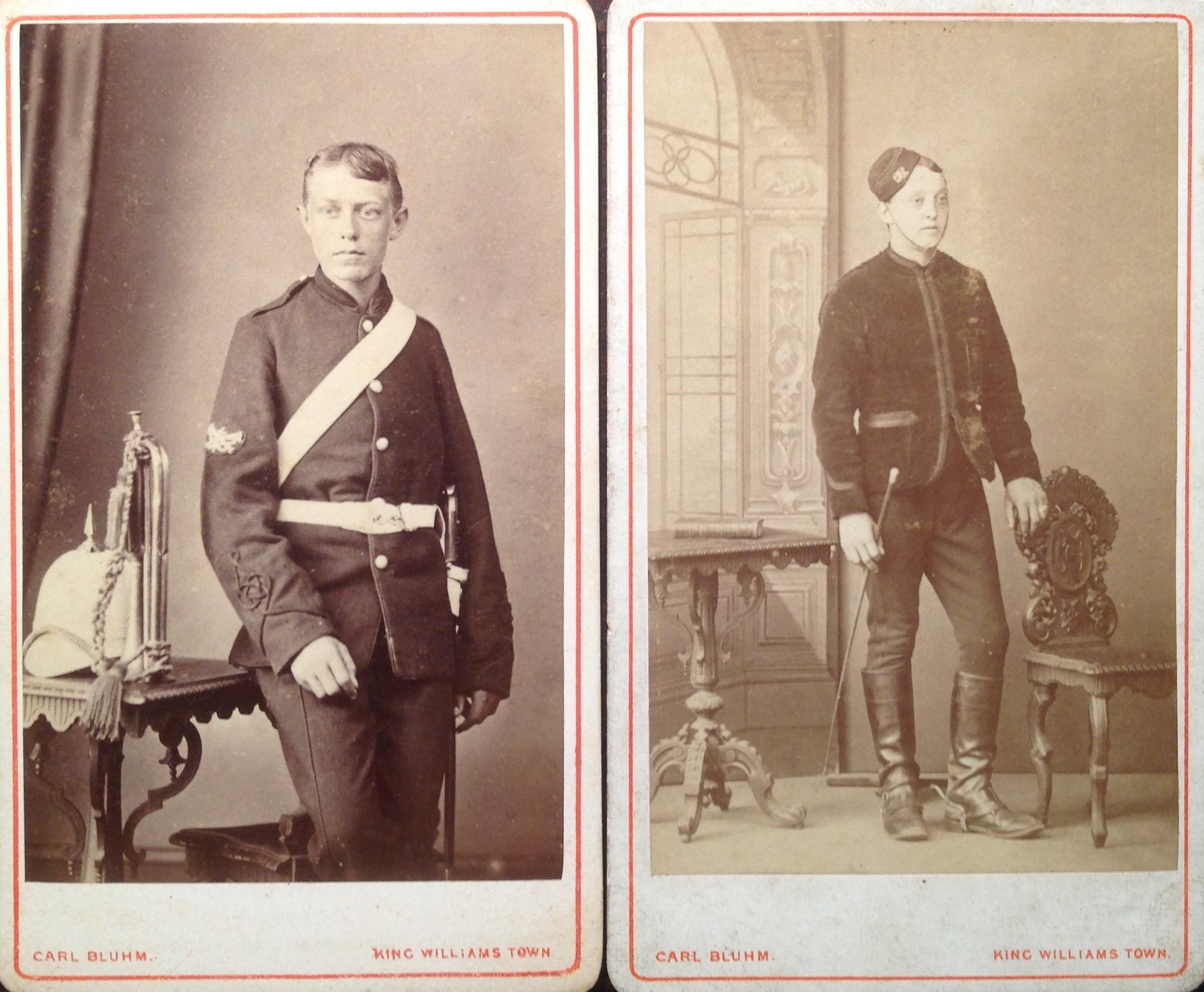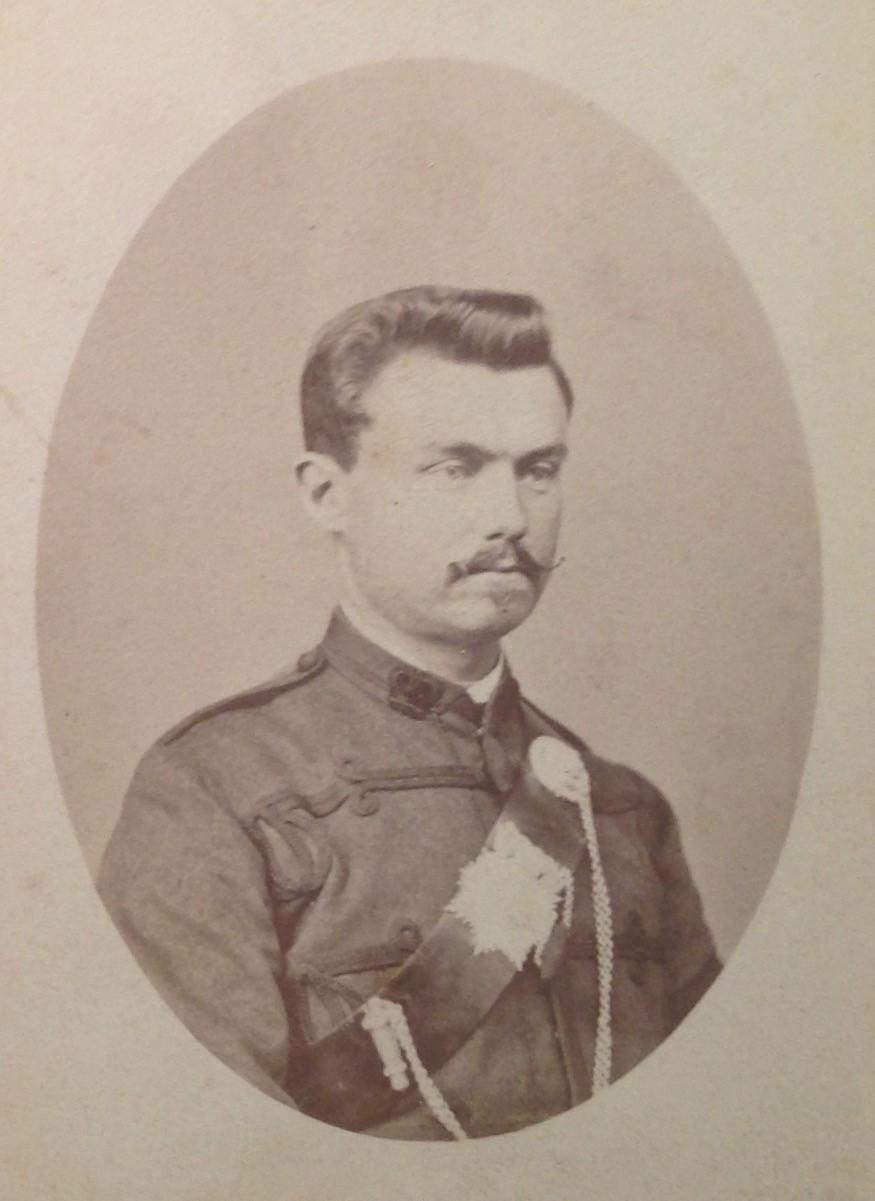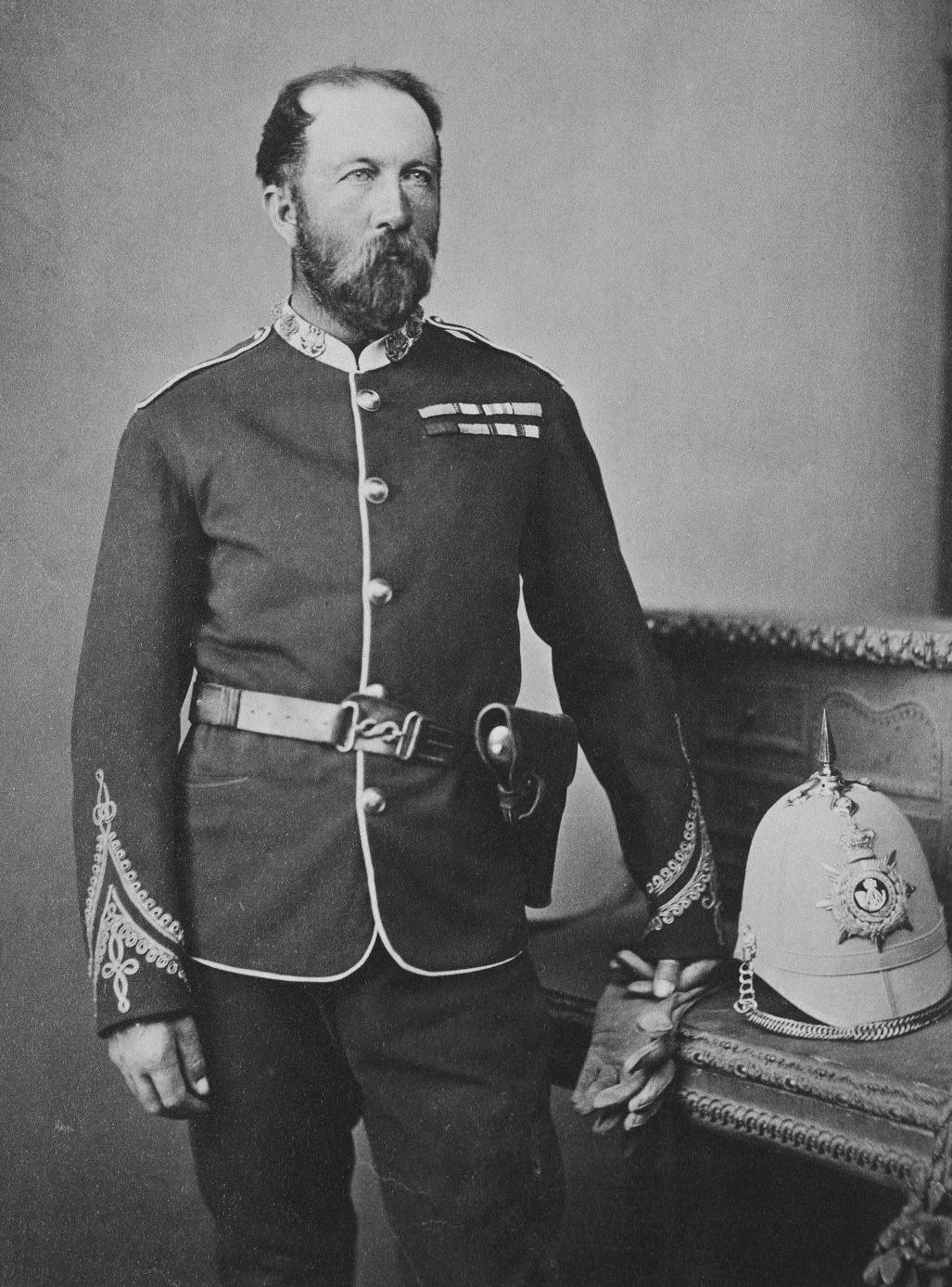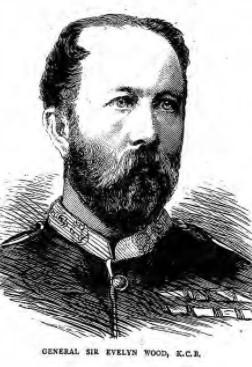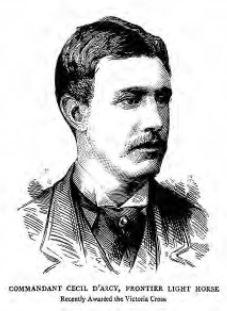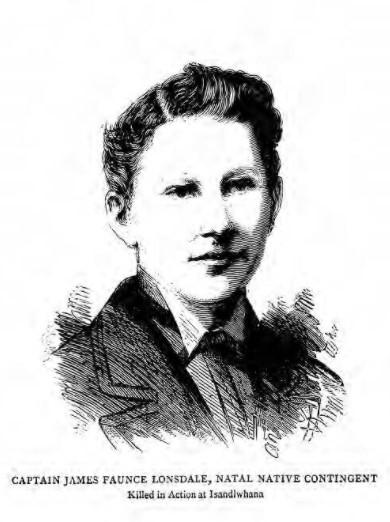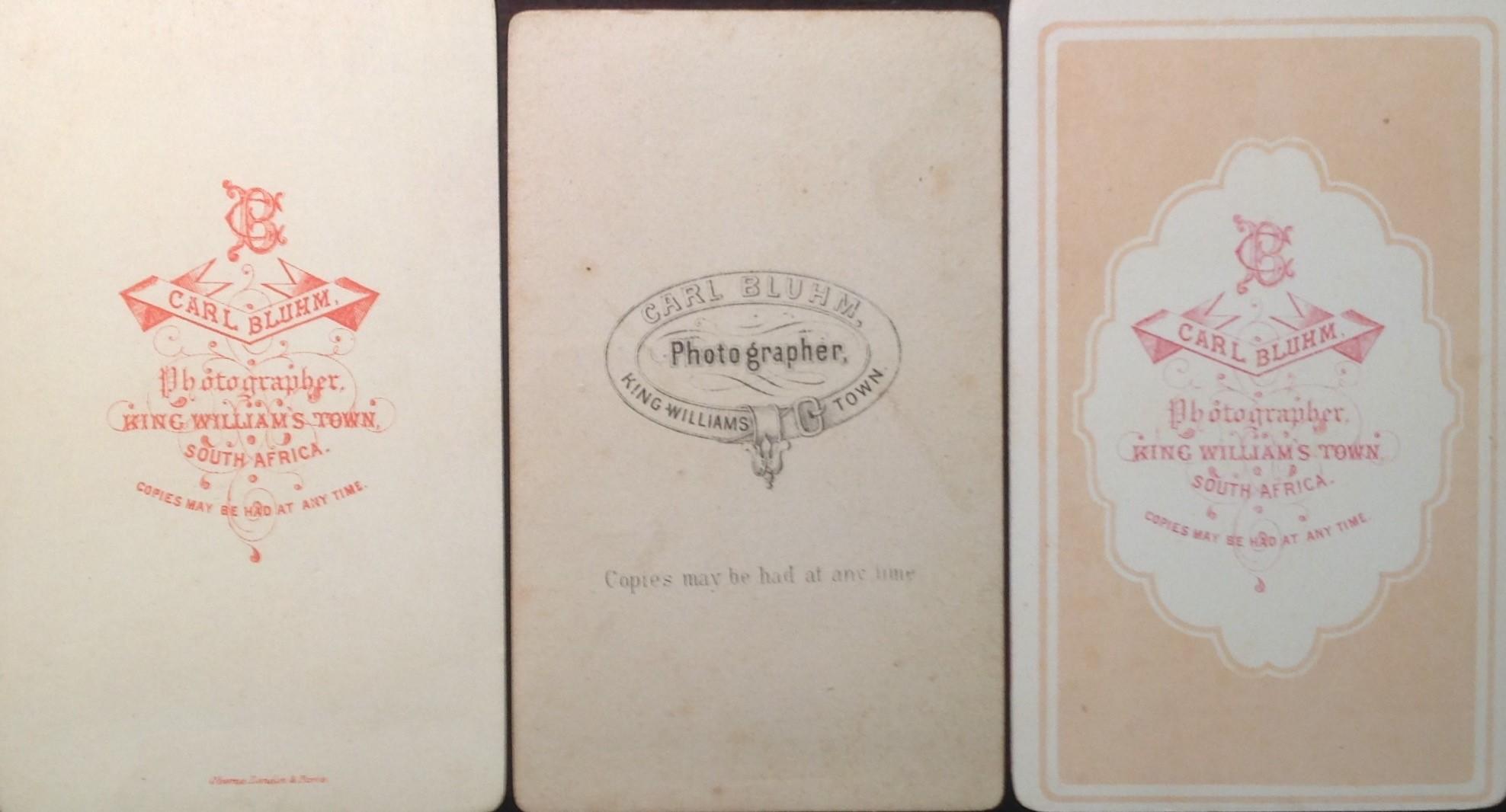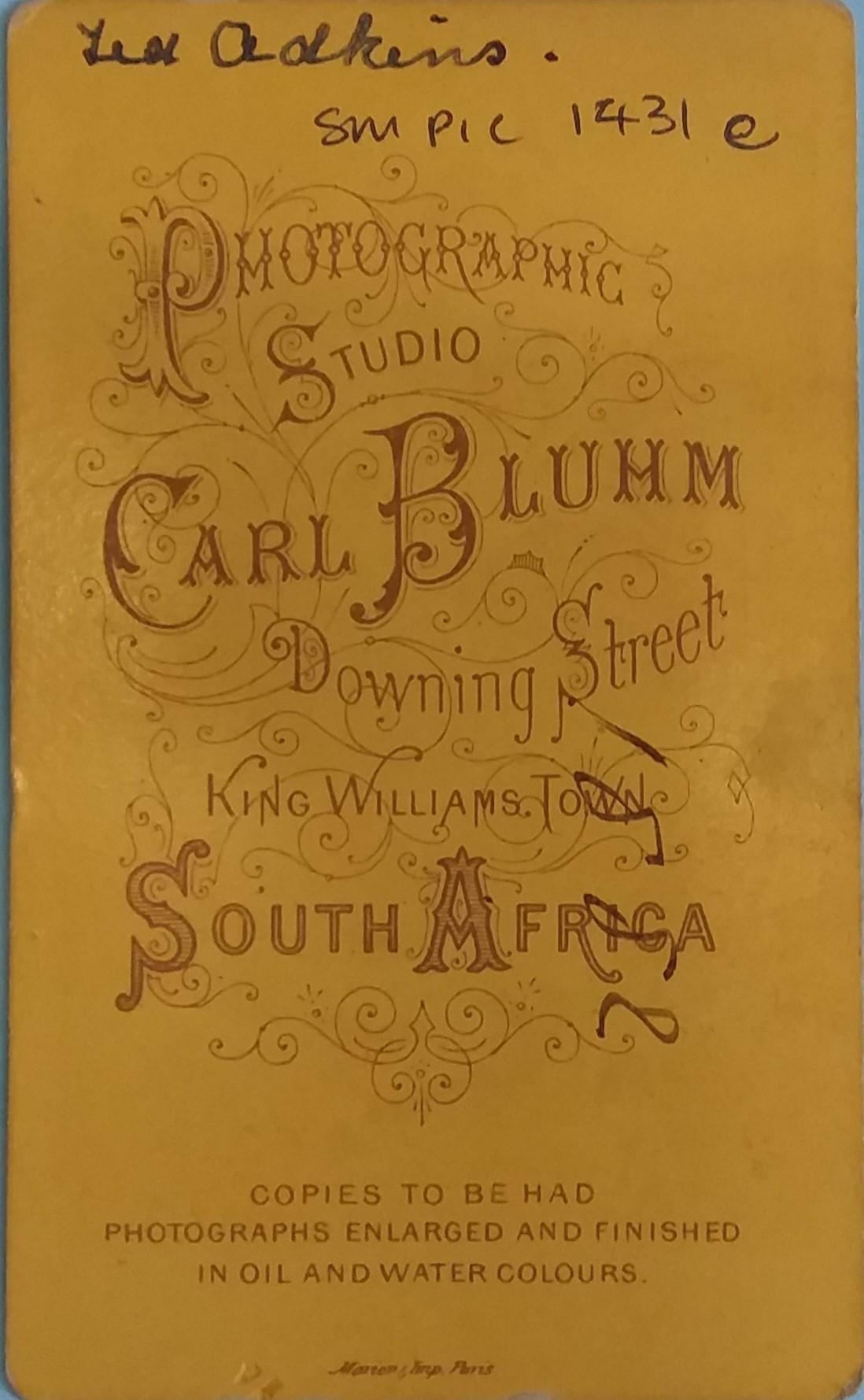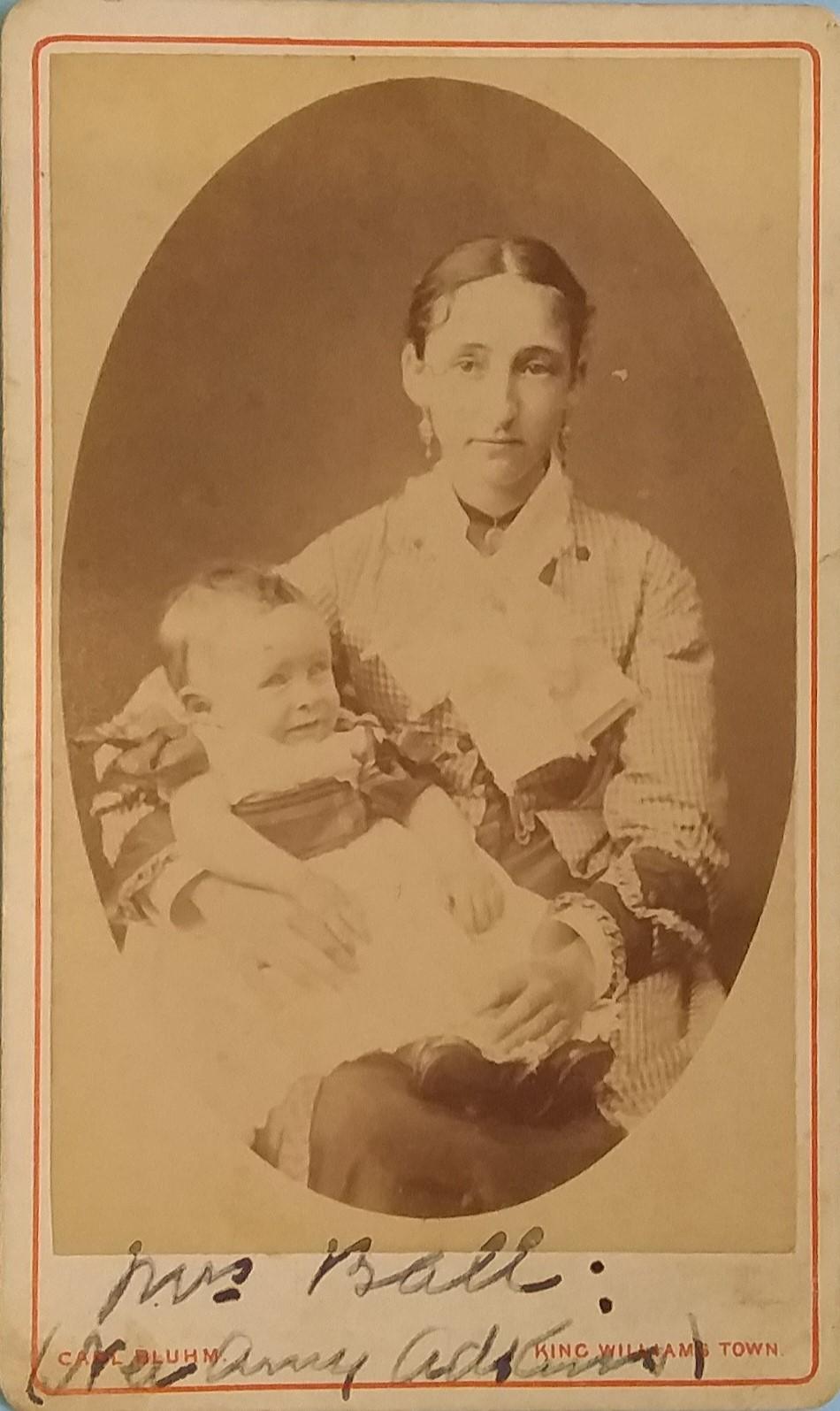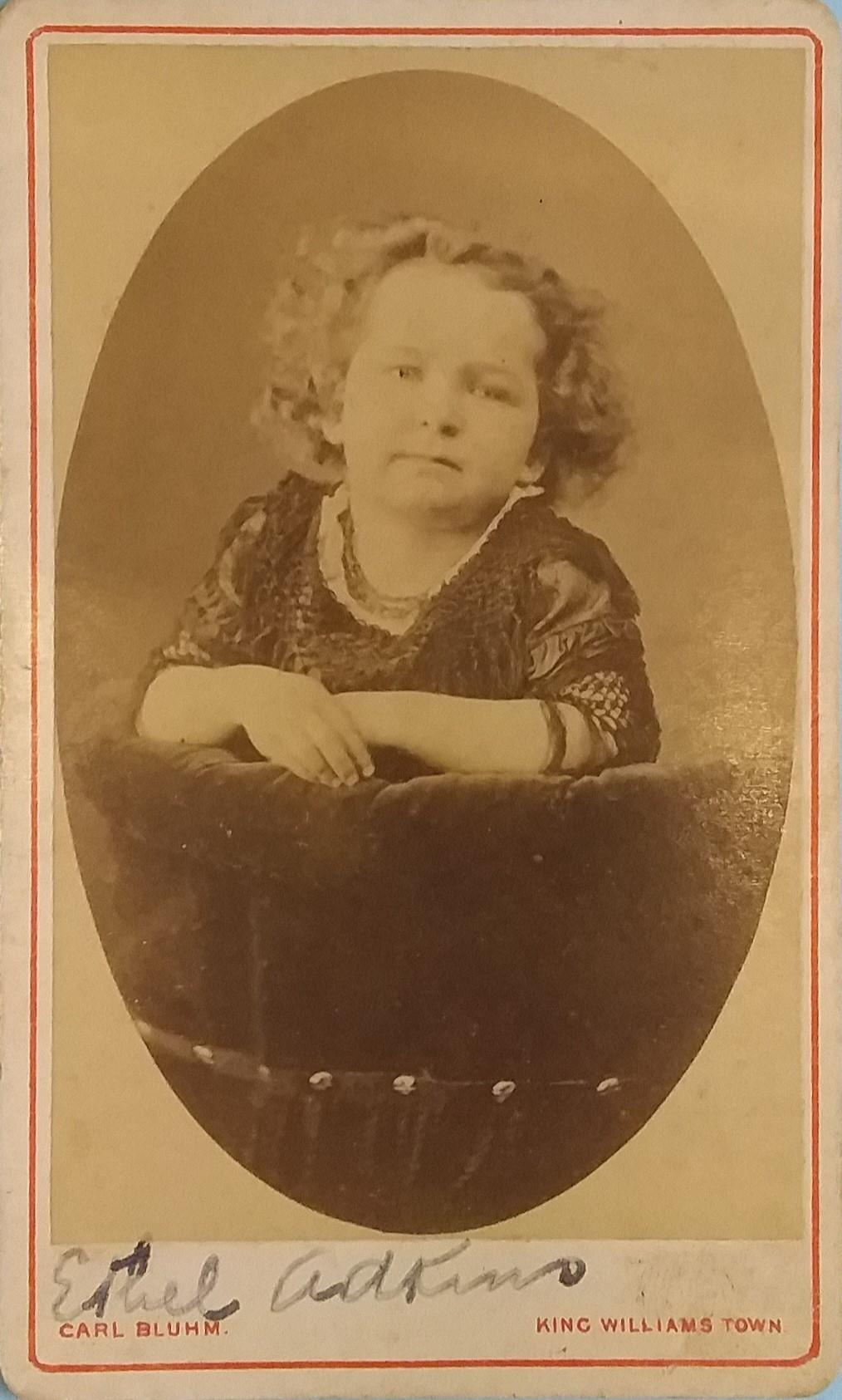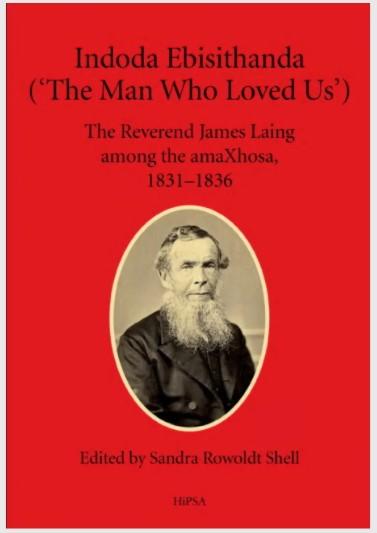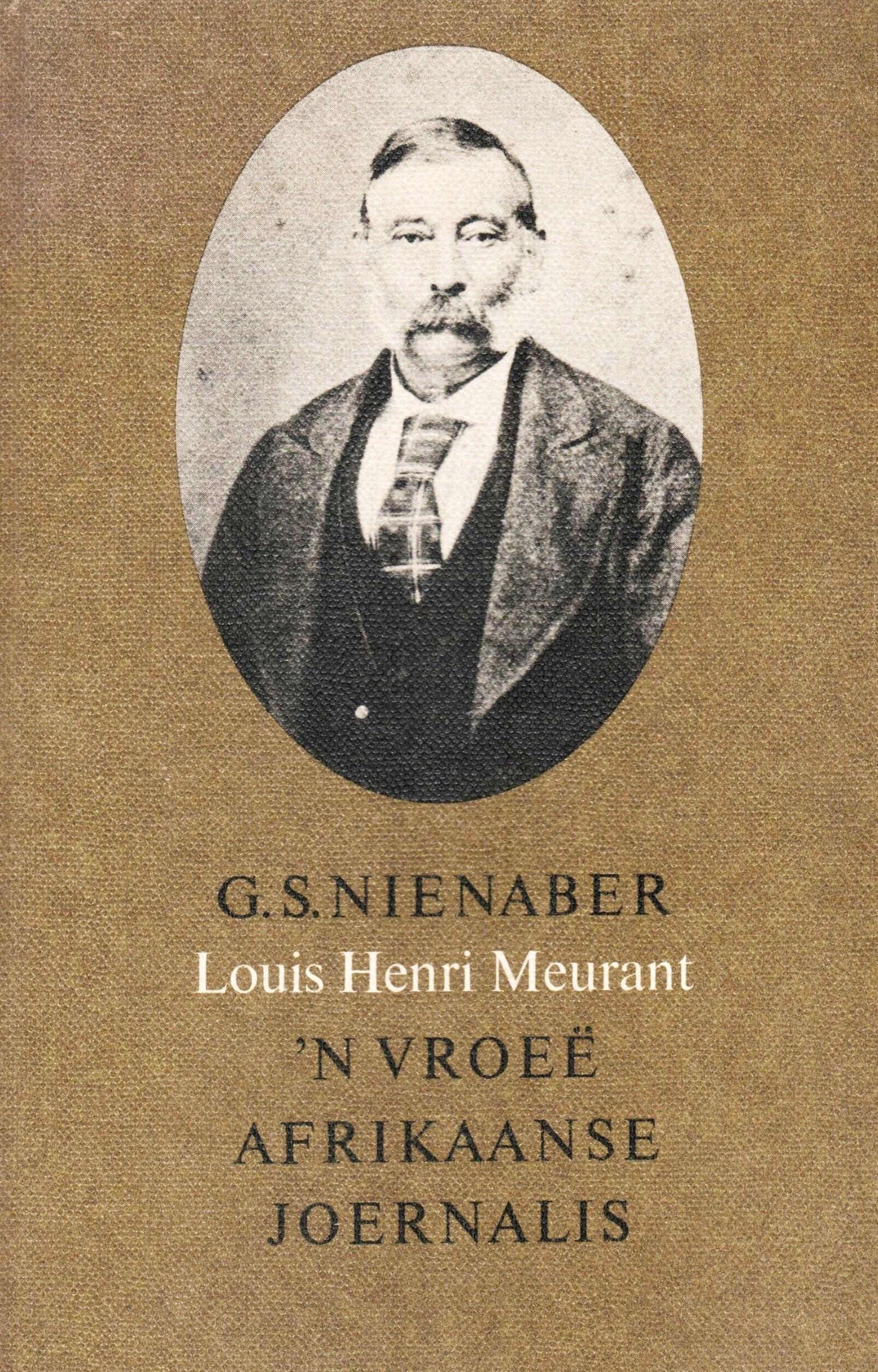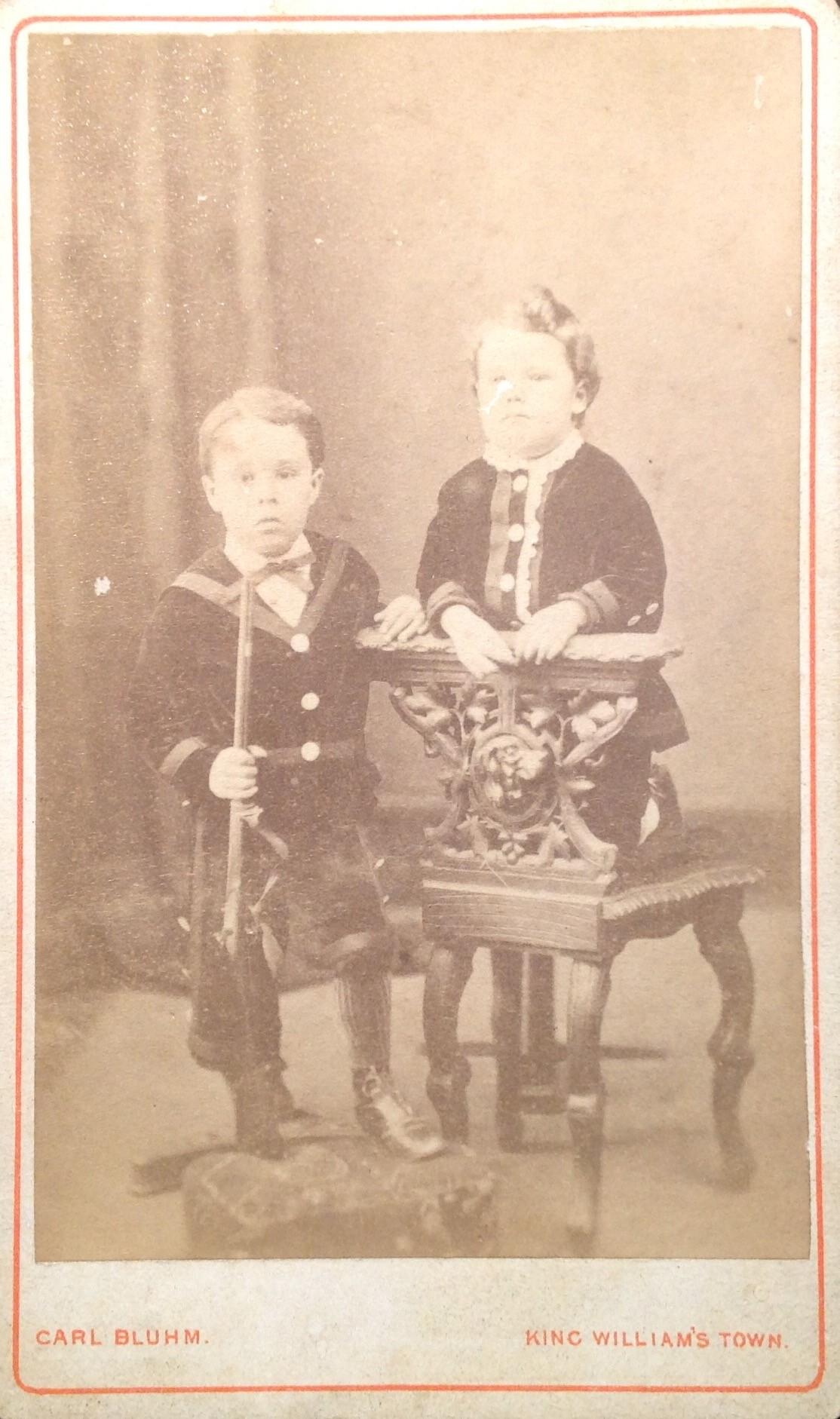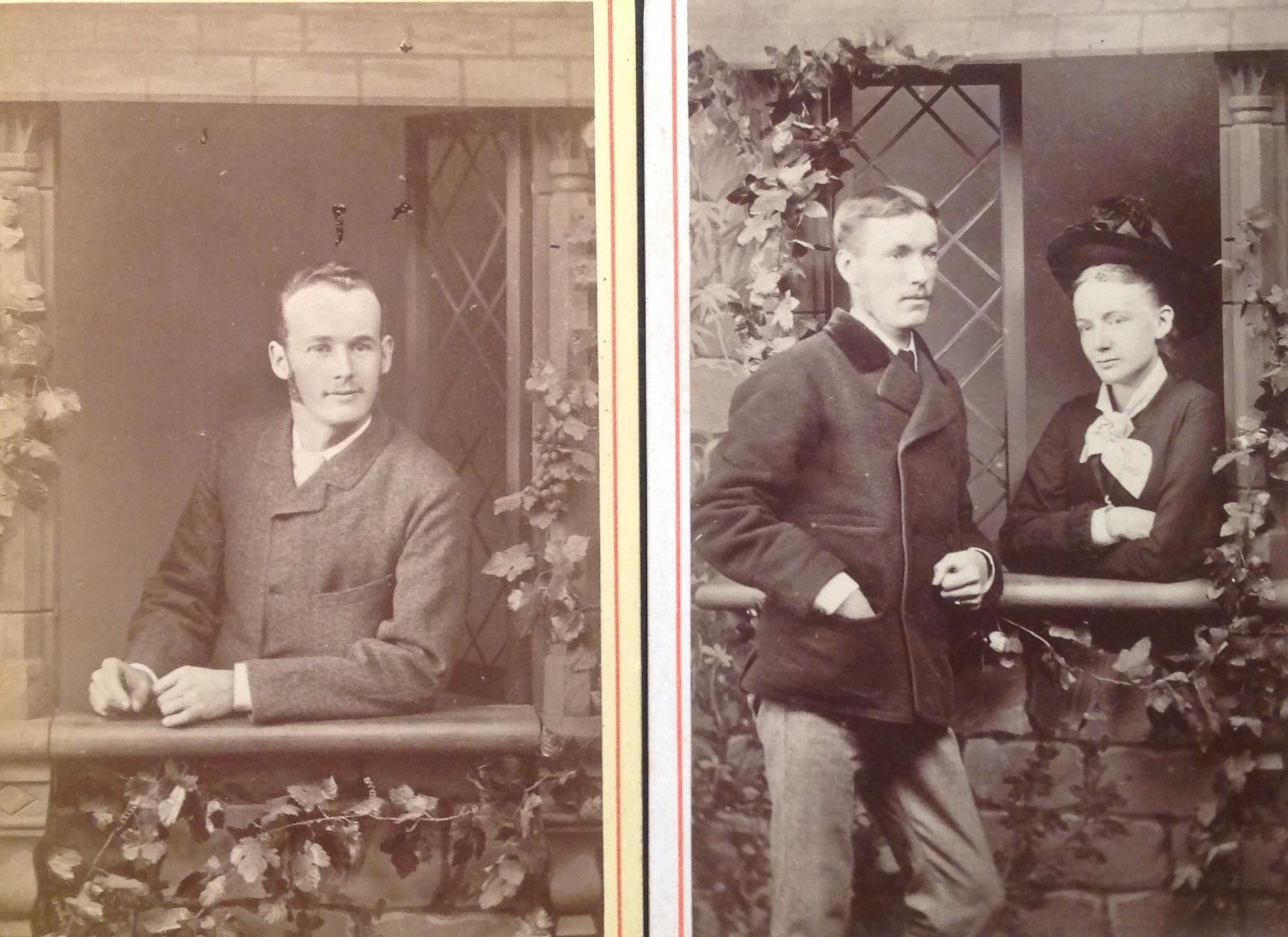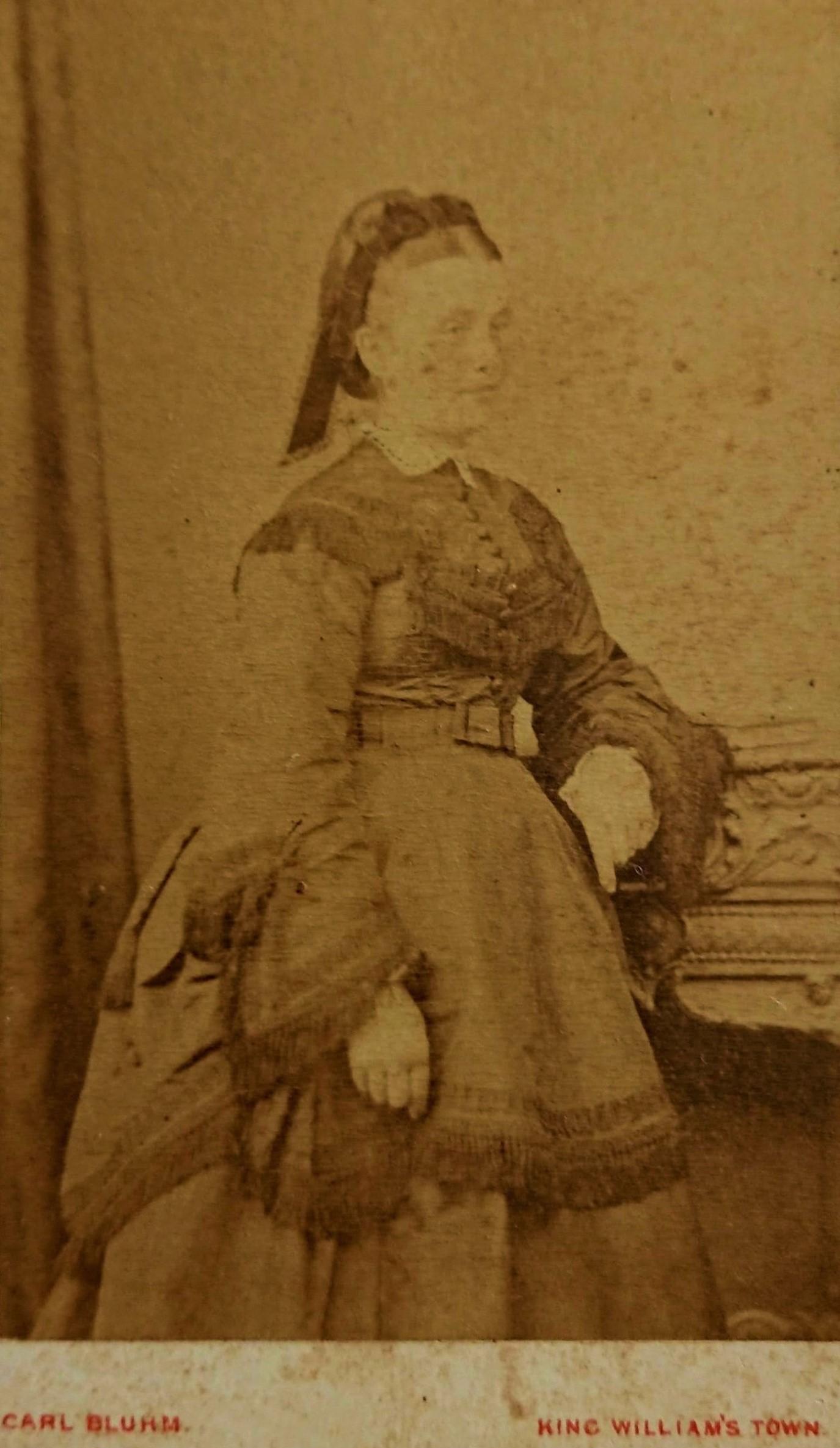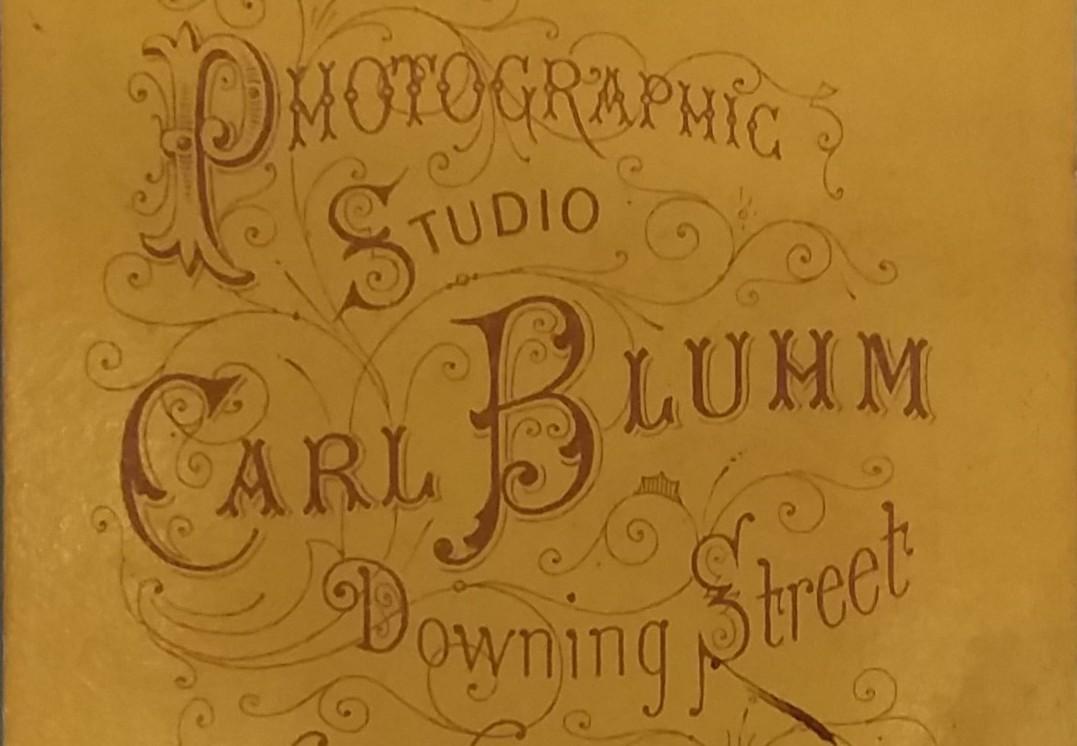
Disclaimer: Any views expressed by individuals and organisations are their own and do not in any way represent the views of The Heritage Portal. If you find any mistakes or historical inaccuracies, please contact the editor.
This article is based on the combined resources of the two authors. Carol Hardijzer has an avid interest in 19th Century photography in South Africa and his research and collection of Carl Bluhm photographs compliments the fairly extensive family research conducted by Margaret Addis, great-great granddaughter of Carl Bluhm, an early photographer based in King Williams Town (Qonce today). Together, they have amassed a significant number of Bluhm’s images, the originals in Hardijzer’s collection, as well as many digital copies of photographs captured by Bluhm, which Addis either extracted from the internet or obtained from various local and international archives, correspondents and local Cape based museums and libraries.
Carl Bluhm (1827 – 1897) – Photograph reproduced from Secure the Shadow
The surname Bluhm was first found in Lower Saxony (Germany), where the name emerged in medieval times as one of the notable families of the Hanover region. From the 13th century the surname was identified with the great social and economic evolution which made this territory a landmark contributor to the development of the German nation. From the 14th century the name was associated with a Patrician family (part of aristocratic lineage) that possessed estates in the Calenberg and Minden region (houseofnames.com).
Whilst various spelling variations of the surname exist, the meaning of Bluhm translates into “flower”.
1. Background
Adolph Carl Friedrich Bluhm was born in Kiel, Germany, on 11 May 1827. He was one of at least seven surviving children.
His parents, Johann Nicholaus Christian Bluhm, a Doctor of Philosophy, and Margaretha Dorothea Johanna (born Neuhaus) married on the 23 December 1819, in Kiel and shortly thereafter moved to Kellinghusen, where Johann had taken over an apothecary business (Schneider, 2020). Five children were born to the couple in Kellinghusen, two of whom died in infancy. They moved to Kiel somewhere between 1826 and Adolph Carl Friedrich’s birth in May 1827 and lived there until at least 1831 during which time three more children were born to the couple, the last being twin daughters. The family must have moved again as no further trace of them has yet been found.
Whilst still in Germany, Carl Bluhm, as he was more commonly known, served as a second lieutenant in the Schleswig-Holstein army that fought the First Schleswig war, also referred to as the Danish-German war or the three-year-war (1848 – 1851).
During 1855 he signed the oath of citizenship in Kiel giving his occupation as Kaufman (merchant).
Carl Bluhm married Maria Margaretta Catherine (born Munsfeldt) in Germany, where the first of their eight children, Carl Wilhelm, was born around 1855.
The Bluhm couple’s remaining 7 children were all South African born.
Carte-de-Visite format studio photograph of unknown elderly lady by King Williams Town based Carl Bluhm. Note the exquisite antique furniture (Circa late 1860s). Type 1 back.
Carte-de-Visite format studio photograph of three unknown brothers by King Williams Town based Carl Bluhm (circa mid 1870s). Note how a part of the head clamp shows just above the right ear of the older boy. Head clamps were in use in earlier studio settings to prevent sitters from moving due to longer exposure times. Card is a Type 2 back.
Carte-de-Visite format studio photograph by King Williams Town based photographer Carl Bluhm of Ina Robson at around 18 years old (Circa mid 1870s). Classina Elizabeth Robson was born around 1857 and died a spinster in Bedford (Eastern Cape) on 12 April 1941. With Type 2 back.
Carte-de-Visite format studio photograph by King Williams Town based photographer (circa 1870) of Margaret Ross (born Brown). She was born about 1832 in Scotland, wife of Rev Bryce Ross, a Presbyterian minister at the Pirie Mission Station near King Williams Town. She died on 8 September 1923 aged 91 and lies buried at the Pirie Mission.
2. Bluhm’s arrival in South Africa with the British-German Legion
Carl Bluhm has become somewhat of an enigma to researchers. Whilst it was stated in the book “Secure the Shadow” (Bull & Denfield, 1970) that he arrived as an Ensign in the British-German Legion, there is little evidence that definitively links him to the British-German Legion settler group (military settlers) that were offered land in the Eastern Cape, as he is not listed on any of the archival settler lists, regimental nominal rolls, regimental paylists, nor have his enlistment papers been traced to date.
Although no concrete evidence has been found to support his link to the British-German legion, one can however assume the veracity of Bull and Denfield’s (1970) statement that Carl emigrated to South Africa in early 1857 with his wife, Maria and their 2-year-old son, Carl Willem.
The fact that Bluhm was listed along with other legionnaires as being allocated land in Braunschweig in the Eastern Cape, a village and former district of King Williams Town (Schwär & Pape, 1985), is believed sufficient evidence to confirm his enlistment with the British-German Legion. His death record, furthermore, noted his occupation as “Retired Photographer, formerly officer in the German Army” and the address of his place of death, “At his residence, Military Reserve, King Williams Town.”
Schubert (2021) states that the legion is correctly referred to as the British-German Legion, not the German legion as it is often called, in that not all the soldiers who enrolled at the time to fight for Britain in the Crimea were, in fact, German. Many of the officers were British and there were at least a few French and Swiss men among them. Queen Victoria insisted on including the word German in the name, as her mother was German.
Lossau (2021) states that the “gentlemen cadets” who came to the Cape were former officers/ensigns in the original German legions. When the regiments came to the Cape there were too many officers in relation to the actual troops resulting in the British authorities refusing to allow (and pay) all of the officers that had signed for the Cape. The authorities therefore had to make another plan and reclassified some of the officers, once in South Africa, as “cadets”. Carl may have fallen into this category having previously held the rank of lieutenant.
Other possibilities as to why Carl’s name is not on any of the official lists are that he may either have been a “late” recruit for the Cape, or that he may have enlisted under a different name. Lossau (2021) explained that many men enlisted into the German Military Regiments under false names as the signing of allegiance to a foreign power was considered treason, according to German Law at the time. It was often the practice, therefore, for the men who signed up as officers and ensigns to use false names as they generally came from more well-to-do families and therefore had higher profiles. Ironically, Carl’s younger brother, Georg Wilhelm (born 1830), has been recorded as not having reported for military service in Germany since 1855 and having emigrated illegally from the country during 1861. The assumption was made that he immigrated to Maracaibo (Venezuela) at the time.
The first Governmental record of Carl Bluhm in South Africa seems to be the Cape Authorities letter of his naturalisation (25 January 1866).
At least one other German soldier that obtained prominence as a formidable photographer in South Africa is also recorded to have disembarked in East London on New Year’s day of 1857, namely Captain Carl Otto Mehliss.
Carte-de-Visite format studio photographs of two gentlemen circa mid-1870s by King Williams Town based Carl Bluhm. The photograph on the left is of Lieutenant Whiteford. The photograph on the right is of an unknown gentleman. Both with Type 1 backs.
Carte-de-Visite format studio photographs of three unknown ladies circa mid 1870s by King Williams Town based Carl Bluhm. Bluhm clearly had a preference towards placing the sitter in an oval setting when producing the final image. All three cards have Type 2 backs.
Carte-de-Visite format studio photographs of two unknown young men by King Williams Town based photographer Carl Bluhm. Circa late 1870s. Both cards are with Type 2 backs.
3. Bluhm’s photographic and studio activity
Carl Bluhm’s South African based photographic activity spans a period of 18 years (1864 – 1882). His career was, however, tragically cut short following an injury at the age of 55 – more about this later.
To date it has not been determined what Bluhm did in the seven-year period between his arrival in South Africa during 1857 and him establishing his first studio in 1864. It is likely, however, that he was either still serving within the legion or perhaps farming the land he had been allocated.
Bluhm was an enterprising individual with respect to his photography business. He not only took the run-of-the-mill studio portraits, but amongst other also took advantage of the nearby military units by setting up a studio in the barracks, he travelled around with his mobile blue glass house studio, photographed scenic views and also advertised hand coloured and life -size studio photographs.
Example of a hand coloured Carte-de-Visite format studio photograph produced by Carl Bluhm (circa 1875) of unidentified soldier thought to have been attached to the Durham light infantry battalion.
Carl was, however, not the first photographer to establish himself in King Williams Town in that Denfield (1965) suggests that by 1858, there were already two established photographic studios in King Williams Town.
The various newspaper advertisements included below, placed by Bluhm over a period of time, assist in putting together a narrative of his photographic activities. They also confirm that he had travelled extensively in order to generate an income from his profession, thus leaving his studio to an assistant to manage.
During June 1864, Carl Bluhm took over Irish born hotel proprietor Michael Henry Durney's studio in the oldest street in King Williams Town, namely Berkeley Street (also recorded as Barkly street). Durney started his photographic activity in the Sutton’s Hotel before establishing his studio in Berkeley street during 1861. Bluhm allegedly, at the point of taking over the Durney studio, disclosed that he had acquired experience in photography while still in Germany (Bull & Denfield, 1970).
The following advert placed in The King William’s Town Gazette (29 May 1865) shows the enterprising Carl Bluhm so early in his career as not only taking studio photographs, but having expanded his business to include groups and views:
Sennotype Portraits (in natural colours). C. Bluhm is now taking the above in a first-class style, at the following low rates: Picture size, in superior frames, from £2 to £2 10s. Small size do., in cases 25s to 30s. And having received a new lens, will continue to take Cartes de Visite, Groups and Views, at very reasonable rates. Berkley Street. C. Bluhm
King William's Town was at that time a garrison town. During 1868, Bluhm had erected a studio in the Royal Engineer's Barrack Yard to cater for the many troops stationed there so that the military could have their portraits taken as well as order views of the town to send to their families overseas (Bull & Denfield, 1970).
Five years after starting his photographic business, it seems that Bluhm relocated to another studio, also in Berkeley street, in that it is recorded that on 2 December 1869 Carl Bluhm opened his new photographic saloon in Berkeley Street and later made important additions to this studio (Bensusan, 1963).
Denfield (1967) reflects on the occasion during May 1869 when, because there was no resident photographer in East London at the time, the Committee of the East London Agricultural Society invited Bluhm to East London to take photographs of the judges of the third agricultural show, which he duly did.
Unusual photograph taken by Carl Bluhm of the judges at the 3rd Agricultural show held in East London during May 1869. This is one of the first recorded photographs to have been taken in East London by a professional photographer.
Whilst in East London, Carl Bluhm also captured some of the earliest recorded photographs of East London, which apparently made headline news at the time and were sold in bookshops as far afield as Cape Town.
Bull & Denfield (1970) make reference to Bluhm using a transportable blue glass house during 1870, which had originally belonged to the photographer Arthur Green. Not all constructed of glass, this hut-like arrangement with slightly tinted panes of glass in its roof and wooden walls (acting as skylights) was easily transportable by wagon, as well as easily erected and dismantled.
Photographers needed a lot of light and it was not uncommon in the earlier days of photography for photographs to be taken out in the open. In the Eastern Cape, where photographers were inclined to go from town to town, glass houses seemed to be the answer to their lighting problems.
While William Waller is accredited as having acquired the first blue glass house in South Africa during June 1858 (Bull & Denfield, 1970), the blue glass house, so called due to the tint of the glass, was new to the Cape. Arthur Green’s blue glass house served the Eastern Cape for many years through a succession of photographers, finally ending up in King Williams Town where, in 1870, it was still being used by Bluhm.
In the Fort Beaufort Advocate (Sat 4 March 1871) the following advertisement was placed:
Photography - Carl BLUHM begs to inform the inhabitants of the town and district that he intends visiting Fort Beaufort at the latter end of the present or beginning of the ensuing month, for the purpose of taking views of the surrounding country. In order to give an opportunity to those desirous of having their Portraits take, he will remain a few days in Fort Beaufort and Alice, to execute orders which may be left at the office of the “Advocate”
A few days later the following was stated in the same publication (Fort Beaufort Advocate - 11 March 1871):
Mr. CARL Bluhm has arrived and is now prepared to take photographs in the first style of art.
An albumen print photograph by Carl Bluhm taken at the Lovedale Institution (Mission station). Seated in front is Dr Jane Elizabeth Waterson. The men, standing from left are Reverent Elijah Makiwane, Pambani Mzimba and J.K. Bokwe. This image was extracted from African Media Online – Cory Library
Carte-de-Visite format studio photograph of Antyi Majiza (born at Burn’s Hill during 1858) by King Williams Town based photographer Carl Bluhm. After studying at Lovedale she later became an assistant teacher at the Girls’ School.
Clearly a photographer in demand, an invitation was again extended to Bluhm during May 1877 to travel to East London to photograph the steam paddle tug, Agnes, just prior to its launching. The Agnes was the first vessel of its kind constructed and launched in South Africa. Initially “put together” by B & H Green of Blackwell in England, it was then totally dismantled and sent out to East London in 266 packages. The opening of the railway line from King Williams Town to the East London in the same year would have made Bluhm’s journey to the port much more comfortable than his previous trip by wagon. Bluhm not only captured the photographs of the tugboat whilst in East London, but also of other tugs in the river, namely the Buffalo and the London (Denfield, 1967).
The next advertisement in Kaffrarian Watchman (17 June 1878) states:
Notice - Mr Carl Bluhm begs to intimate that his Photographic Business will be carried on as usual during his absence from the Colony. Mr C.W. Bluhm holds his Power of Attorney (This was his eldest son).
With all his travels and the above reference to his absence from the Colony, Bluhm must have had one or more assistants to run his studio while he was away, these perhaps being his two eldest sons, Carl Wilhelm and Gustav Otto Hugo, commonly known as Hugo, then aged 23 and 21 years old respectively. It is known that Bluhm’s second son, Hugo, was, at least for a time, also a photographer, as this is the occupation noted on his death record in 1891, but the above advertisement suggests that his eldest son, Carl Wilhelm, may also have acted as a studio assistant during his father’s absence. Carl Wilhelm did not pursue photography as a career but went on to run stationery/tobacconist shop in King Williams Town.
Although it is unlikely that he travelled as far afield as Natal, Bluhm also captured a number of photographs of British soldiers who participated in the Zulu war (1879). With King Williams Town being a garrison town, one can only suppose that the soldiers would have been in transit through the Eastern Cape at the time. Examples in the Hardijzer Photographic Research Collection of such photographs being taken in the King Williams Town based studio in Berkeley street support this theory.
Portraits of several British soldiers who served during this period were etched from Carl Bluhm photographs and published in the British Journal ‘The Graphic’ along with the accounts of their heroic deeds (see images below).
Carte-de-Visite format studio photograph by King Williams Town based photographer Carl Bluhm of two unknown young men in uniform. The image on the right dates from around the late 1870s whilst the image on the right dates from the early 1870s. Note the head clamp stand behind the young soldier on the right. Both have Type 2 backs.
Carte-de-Visite format studio photograph by King Williams Town based photographer Carl Bluhm of unknown Zulu war soldier (1879) with a Type 3 back.
Studio photograph of unknown format (probably Carte-de-Visite) of Brigadier General Sir Evelyn Wood captured by Carl Bluhm in King Williams Town. Wood was attached to the Flying Column during the Zulu war. This very same photograph was used to produce the engraving for The Graphic newspaper (See below).
Engraving produced of Brigadier General Sir Evelyn Wood from a Carl Bluhm photograph (see above). This engraving appeared in The Graphic of 13 September 1879.
Sketch made from a Carl Bluhm photograph of Commandant Cecil D’Archy which appeared in The Graphic of 27 December 1879. D’Archy was attached to Buller’s Frontier Light Horse. It is recorded that he distinguished himself by repeated acts of bravery, one being giving up his horse to a wounded trooper when hotly pursued by warriors at the Zhlobani Mountain. D’Archy reported to Brigadier General Sir Evelyn Wood whose photograph is also included in this article.
Sketch made from a Carl Bluhm photograph of Captain James Faunce Lonsdale who was killed in action at Isandlwana which appeared in The Graphic of 16 August 1879. Legend has it that the original of this enlarged photo portrait is still hanging on a wall somewhere South Africa.
Evidence that Bluhm had expanded his business further to meet a growing demand can be found in the Kaffrarian Watchman - 17 November 1880, where he advertized to the public:
C. Bluhm Photograph artist estblished 1864. Photographs taken daily in the most approved style, from Carte-de-Viste to Life Size. Any portraits enlarged and painted to colours. Views of Town and Country and photographs of natives.
By this time he was not only producing his normal Cartes-de-Visite, groups and scenic shots, but images of any size, to life size, and the enticing option of including colour. Also included in his range were “photographs of natives”, showing that Bluhm, along with a number of earlier South African photographers, quickly understood that there was a healthy market abroad (mainly Europe) for images of the African continent’s black population.
Early in 1881, Carl Bluhm and his family spent a holiday at East London and it has been suggested that it was during this holiday that he secured for posterity many of his best records of the town and harbour. Some of these scenes included shipbuilding in the boatyards of local shipping and landing companies, old buildings on the West Bank, the Marine Hotel, and the Oddfellow’s Hall. Many views of Panmure were included in his comprehensive portfolio of East London (Denfield, 1967). It was also suggested that he had an assistant with him at the time, as among the photographs were some of Bluhm, himself, enjoying the day out with his family in a boat on the Buffalo River. The “assistant” could very likely have been one of his eldest two sons.
During 1882, Bluhm moved his studio from Berkeley street to Downing street in King Williams Town (Bensusan, 1963).
Although versatile in in his approach to photography, Bluhm never seems to have converted to Cabinet Card format studio photographs. Research to date has only surfaced Carte-de-Visite (CdV) format studio photographs produced by him. The CdV format was in use in South Africa between the early 1860s to mid-to-late 1870s before the Cabinet Card (larger format) became a more popular format.
Four different types of Carte-de-Visite backs used by Carl have been identified to date. These backs assist in dating the images (See photographs below showing 4 different backs):
- Type 1: With belt - roughly 1864 to mid-1870s;
- Type 2: Without frame, but with or without company/country where the stock cards were printed at the bottom of the card, namely Oborne printers based in London & Paris – roughly mid to late 1870s;
- Type 3: Same as above, but with frame (in different colours) – roughly late 1870s to 1882;
- Type 4: The scarcer of the 4 types in that this is the card he used for a short while whilst based at Downing street (1882 into 1882).
Backs of three of the four Carte-de-Visite used by Carl Bluhm. The back of the cards assists in the dating of the photographs. The card in the middle is found on Bluhm’s earlier images (Roughly 1864 to mid-1870s = Type 1), followed by the card on the left (roughly mid to late 1870s = Type 2) and then the card on the right (roughly late 1870s to 1882 = Type 3). Type 3 was produced in different colours. Type 4 had the Downing studio address and was therefore in use for a very limited period (1882/3) – It is therefore the scarcer of the 4 Types.
Back of the 4th type of Carte-de-Visite used by Carl Bluhm. What makes this version unique is that Carl was only active at the Downing street studio (his last) between 1882 and 1883, which makes this a scarcer type compared to the previous cards in use.
4. Injury brings Carl’s career as a photographer to an end
Carl Bluhm’s photographic career was sadly cut short at the prime of his career following a wagon accident during which he obtained an injury which resulted in him not being able to pursue his career any longer as photographer.
The accident was reported in the local newspaper The Kaffrarian Watchman (21 September 1883).
Ruling Tuesday, September 18, 1883 Civil Cases Bluhm vs Petzer. This was an action brought by Carl Bluhm, a photographer residing in King William’s Town, against Jacobus Hendrik Petzer, a farmer residing at Frankfort, for the recovery of £1,500 in damages for breach of contract in neglecting as agreed upon to carry the plaintiff and his family to and from Perie Bush in the month of December, 1882, without hurt or harm which agreement was broken by the wagon being upset and the plaintiff seriously injured. Advocates Solomon and Burke appeared for plaintiff, and Advocate Brown appeared for defendant. From the evidence adduced it was proved that the wagon had turned off the main road during a time when it was being driven rapidly, and in consequence of which it capsized, and Mr Bluhm was severely injured. The Doctor expressed his opinion that Mr Bluhm was permanently injured, and he appeared in Court upon crutches. His Lordship said negligence had been clearly proved, and although he agreed with Mr Brown that some actions were brought by person for the mere sake of making money by the transaction, he did not think the present case could be classed under the category. He therefore gave judgement for the plaintiff in £300 damages and costs.
Two years later, The Kaffrarian Watchman (11 September 1885) confirmed Bluhm’s insolvent estate.
Whilst the exact nature of the injury is not known, it explains why the King Williams Town studio in Downing street, which opened during 1882 was operative for such a short period. It is assumed that he must have sold the studio in Downing street shortly after his accident to the Ginsberg sisters, who are known to have arrived in King Williams Town during the early 1880s and also had a studio in Downing street.
Carte-de-Visite format studio photograph by Carl Bluhm of Amy Adkins (Amelia Alice Elizabeth). Amy is better known as Mrs Ball of Mrs Ball's Chutney fame. She was the 5th child of 13 children. This photograph, circa 1879/80, is of her as a teenage girl around 16 years old. The child on her lap is thought to be her younger brother Harold Adkins. Also see image below of her younger sister Ethel Adkins (born during 1874) who would have been in the studio at the same time this photograph was captured. Amy was born on 23 March 1865 and died during 1962 aged 97. Amy attended school in King Williams Town. After her marriage to Herbert Saddleton Ball, Amy improved on her mother’s initial chutney recipe during the 1910s resulting in the successful brand it has become today.
Carte-de-Visite format studio photograph by Carl Bluhm of young Ethel Adkins (born during 1874). Ethel was the younger sister to Amy Adkins. See photograph of Amy above.
Carte-de-Visite format studio photograph by Carl Bluhm of Robert Edward (Ted) Adkins – 12 August 1862 to 27 September 1938. Brother to the Mrs Ball’s Chutney famed Amy Adkins. Ted was a storekeeper in Queenstown
Subsequent to his injury, Bluhm involved himself with education among the German children of Breidbach (today a suburb of King Williams Town / Qonce).
Bluhm also took a keen interest in civic affairs. During the October 1877 uprising, for example, he was responsible for organising the Volunteer Company of German Burghers (Bull & Denfield, 1970).
Carl Bluhm died In King Williams Town on the 9th July 1897 and was survived by his wife Marie and five of his eight children. He is buried in the King Williams Town cemetery (Denfield, 1967).
Following her husband’s death, Marie moved to Durban, presumably to be close to her three daughters who lived there. She died in Durban on 24 April 1917 and is buried there in the cemetery at St. Thomas Church, Ridge Road.
5. Bluhm’s significant contribution to photography in the Eastern Cape
Carl Bluhm’s legacy lives on, despite the tragic circumstances that led to his insolvency, in the overwhelming evidence of a successful career and his significant contribution to the early photography of the Eastern Cape. He captured on camera a vast range of subject matter and at least seventy of his images have survived in various archives, museums, libraries and private and family collections, both in South Africa and abroad, which give an insight to life as it was during that time. Some of his subjects distinguished themselves as soldiers, some have had books written about them, with his photographs on the dust covers (see some of the book covers below) and one, Mrs Ball, has become a household name in South Africa.
The original photograph used on the cover of this book by Shell (about the Reverend James Laing) was captured by Carl Bluhm. The original of this photograph is held by the Cory Library.
The original photograph used on the cover of this book by Nienaber (about Louis Henry Meurant) shows an image of Meurant as captured by Carl Bluhm.
Denfield (1967) refers to a Bluhm portfolio, giving the following detailed description of various photographs taken by Carl Bluhm, which unfortunately has not yet been traced:
- A panorama of East London taken from Signal Hill, which gives a most striking picture of the buildings and stores on the Western bank with the Buffalo River and “Pilkington’s Well” in the foreground. Of particular interest is the old “Castle Point” lighthouse with its original approach by a catwalk bridge – 60 ft long (1869)
- A group of judges in the show yard of the Commissariat (1869) – See photograph above
- A picnic party proceeding up the river in boats (1869)
- A whaleboat moored close to the First Creek with the respected Civil Commissioner, Mr Jennings, at the helm and a number of “the notorieties of East London on board” (1869)
- Pictures of the tugboats Agnes, Buffalo and London
- Photographs taken in 1881 of Carl enjoying a holiday in a boat with his family on the Buffalo River
- Shipbuilding in the boat yards of the local shipping and landing companies
- Old buildings on the West Bank – the Marine Hotel and the Oddfellows Hall
- Many views of Panmuir
With some overlap of the above, Bull & Denfield (1970) have five photographs recorded that were offered for sale at the time they were taken. Although none of these original photographs have been traced by the authors, these 150 + year old photographs, which may still surface at local archives or from private collections, would typically have been reproduced at the time and offered for sale directly by the photographer or via bookstores at a national level:
- August 1867 - Complete panorama of King Williams Town
- March 1868 - Photographic groups of cricketers in the recent matches
- May 1869 - Views of East London and the Judges at the Agricultural Show – See photograph above
- August 1869 - Interior of the Town Hall at King Williams Town showing the decorations for the forthcoming Ball
- March 1870 - Presentation of valedictory address to the Cape Mounted Rifles by the Mayor of King Williams Town
6. Bluhm’s second eldest son Gustav Otto Hugo
It was not uncommon for sons to be assistants to their photographer fathers. Whilst there are indications that Bluhm’s eldest son, Carl Wilhelm, also supported his father, his second son, Gustav Otto Hugo, commonly known as Hugo, has at least been recorded as being a photographer, confirming his support to his father. No evidence has been found to date of photographic images produced under Hugo’s own name.
Another such classic example is the Graaff-Reinet based photographer pair William Roe and his son William. Little is known about the son, who clearly functioned as a silent, subordinate partner – as was the case seemingly with Bluhm and his son (Hardijzer & Malherbe, 2018).
It is therefore very likely that Hugo (and his older brother) supported his father as a studio assistant from a young age, whilst his father was travelling. Hugo in all probability still ran the photographic studio in Downing street for a number of months following his father’s accident and thereafter dabbled in photography on his own account, perhaps in conjunction with farming, which was his occupation noted at the time of his marriage in 1886.
Carte-de-Visite format studio photograph by King Williams Town based photographer Carl Bluhm of two unknown siblings. Note the boy holding his toy rifle (Circa 1875). With Type 2 back.
7. Other King Williams Town photographers recorded to date
King Williams Town had many more photographers compared to the port town of East London. The reason for this was in all probability due to King Williams Town having been a garrison town in the earlier years.
To date, the following 23 King Williams Town photographers (individuals or partnerships), active between 1850s and 1915, have been recorded:
- Betton, Alfred
- Carrick Brothers (King studio – 27 Downing street)
- Dersley and Morley – Alexander & Cathcart road (a brother-in-law partnership)
- Dersley, George Henry – Alexander road
- Dobie, Norman
- Durney, Michael Henry (Irish)
- Durney, William (Irish)
- Farrington, WH
- Fressen, Jos – Alexander road
- Ginsberg, Else & Anna – Ginsberg studio – Downing street (German)
- Henderson, Thomas C – Alexander & Cathcart road (British)
- Knibbs, John E – Alexander road (opposite library)
- Koch, AM
- Lindner, Ernst
- McKaige
- Page, John E
- Richmond, M
- Rindl, J – Cathcard road
- Shannon, R – Smith street (Opposite Hains Hotel)
- Shaw, G – Berkley street (British)
- Stumbles Robert Washington – One of King Williams Town’s early photographers (1864) (British)
- Thudhope, GN – 12 Cambridge Road
- Warnecke & Jose
For more information on photographers active in South Africa between 1846 and 1915, see the Hardijzer (2020) updated catalogue of Bensusan’s (1963) 19th Century South African photographers. Click here to view.
Carte-de-Visite format studio photographs by King Williams Town based photographer Carl Bluhm of unknown sitters. A number of Bluhm’s photographs show this impactful and creative studio prop (post 1875). With Type 2 backs.
Carte-de-Visite format studio photograph by Carl Bluhm of Dorothea Louise Butte who was born on 12 March 1820 in Pommerania Prussia. She died in Frankfort (Eastern Cape) on 7 March 1894. Photograph kindly made available by her great-great granddaughter Lyndene Butt Adamson.
Special acknowledgements
- Vuyo Pika of the Amathola Museum (King Williams Town), for providing not only copies of photographs, but all the Kaffrarian Watchman newspaper clippings and other material;
- Fleur Way-Jones and Barry September of the Albany Museum (Grahamstown), for providing copies of photographs;
- Richard Ball of Essex, a descendant of Amy Ball, for providing the Adkins family photographs;
- Lyndene Butt Adamson, who responded to an appeal on Facebook and sent photographs from her family collection;
- Lorraine Tandy (second cousin to Addis), who has independently been carrying out similar research, for generously sharing all the Carl Bluhm photographs that she had collected.
About the author: Carol is passionate about South African Photographica – anything and everything to do with the history of photography. He not only collects anything relating to photography, but also extensively conducts research in this field. He has published a variety of articles on this topic and assisted a publisher and fellow researchers in the field. Of particular interest to Carol are historical South African photographs. He is conducting research on South African based photographers from before 1910. Carol has one of the largest private photographic collections in South Africa.
Sources
- Bensusan, A.D. (1963). 19TH Century Photographers in South Africa. Africana Notes and News. 15(6), 219-252
- Bensusan, A.D. (1966). Silver Images – History of Photography in Africa. Howard Timmins. Cape Town
- Bluhm: Meaning of the surname Bluhm – extracted 25 March 2021 (www.houseofnames.com)
- Bull, M. & Denfield, J. (1970). Secure the Shadow – The story of Cape Photography from its beginnings to the end of 1870. Terence McNally. Cape Town
- Cory Library (Rhodes University) - www.africamediaonline.com
- Denfield, J. (1965). Pioneer Port. The illustrated history of East London. Howard Timmins. Cape Town
- Denfield, J. (1967). East London’s Indebtedness to Carl Bluhm. The Coelacanth. Journal of the Border Historical Society (Vol 5, No 1 - April 1964)
- Durham Country Record Office : (www.durhamrecordoffice.org.uk) - Ref D/DLI 7/1039/1
- Hardijzer, C.H. (2020). Operators of Mirrors with memory. (theheritageportal.co.za) – inclusive of a revised Bensusan list of 19th century South African photographers
- Hardijzer, C.H. & Malherbe, A. (2018). William Roe (1827 – 1916). Long serving Graaff-Reinet based photographer. theheritageportal.co.za
- Hardijzer Photographic Research Collection
- Kiel Stadtarchiv - Kieler Burgerbusch (Citizen's register)
- Lossau, N. (2021). Email communication between Margaret Addis and Nolene Lossau – 10 March 2021
- Nienaber, G.S. (1968). Louis Henri Meurant – ‘n Vroeë Afrikaanse joernalis. Nasionale. Cape Town
- Royal Trust Collection (rct.uk.collections). Photograph - Brigadier General Sir Evelyn Wood
- Schneider, H. (2020). Email communication between Margaret Addis and Heike Schneider – 5 November 2020 (with attachments)
- Schubert, J. (2021). Email communication between Carol Hardijzer and Joachim Schubert - 17 March 2021
- Schwär, J.F. & Pape, B.E. (1985). Germans in Kaffraria (1858 – 1958). Robprint. Pinetown
- Shell, S.R. (2019). Indoda Ebisithanda: The Man Who Loved Us – The Rev James Liang among the amaXhosa. HiPSAThird Series No.1 Cape Town
- Shell, S.R. (2006). A missionary life among the amaXhosa: The Eastern Cape Journals of James Liang 1830 – 1836. Cape Town University
- Struve, K. (Extracted during 2020). Emigration from Schleswig-Holstein. Genealogy in Schleswig-Holstein (http://rootdiggers.de)
- The Graphic (13 September; 16 August & 27 December 1879) – British Newspaper Archives
- Victor, S. (Extracted 31 March 2021). Mrs Ball, KWT, and her famous chutney. Amathola museum (www.museum.za.net)
Comments will load below. If for any reason none appear click here for some troubleshooting tips. If you would like to post a comment and need instructions click here.

